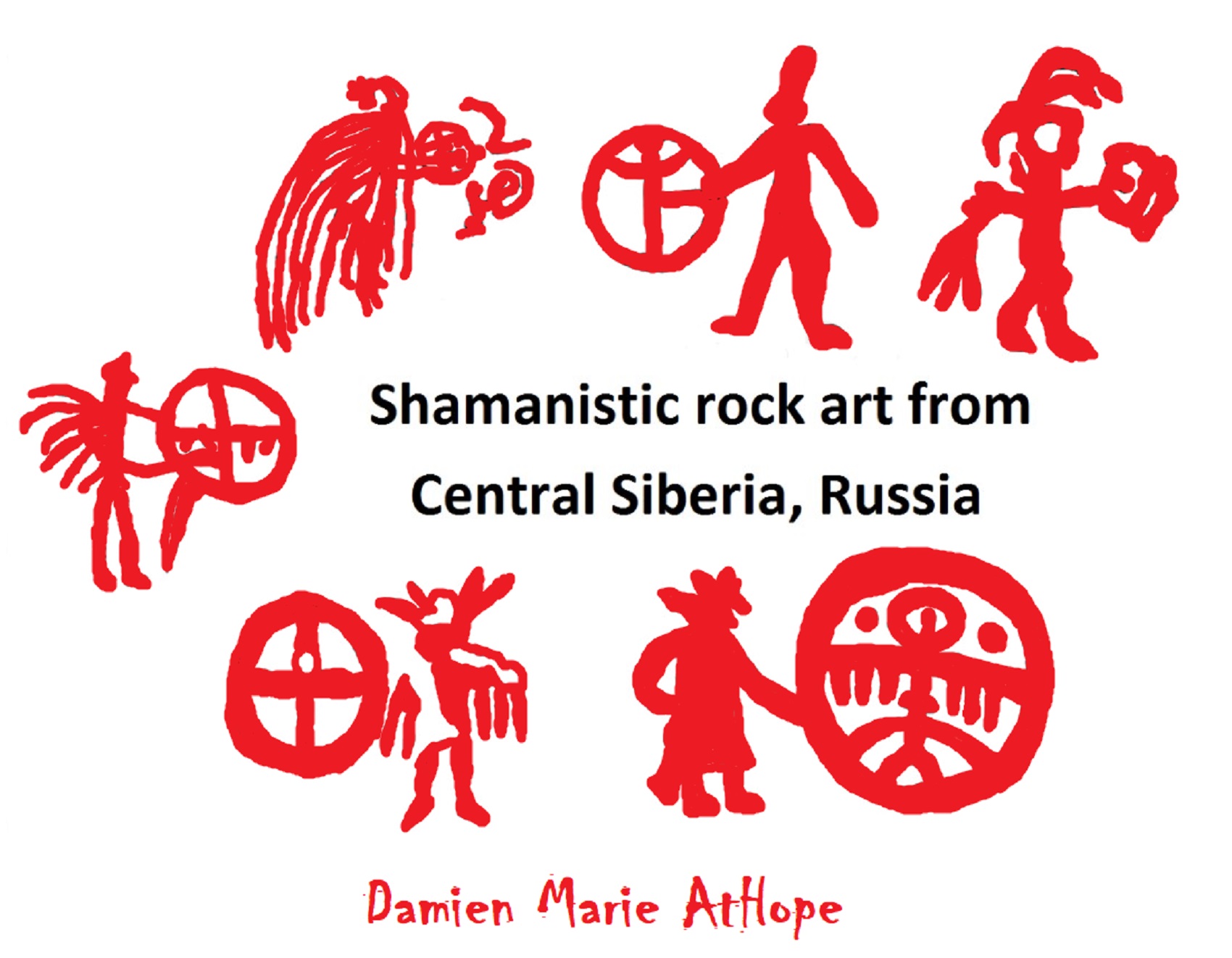
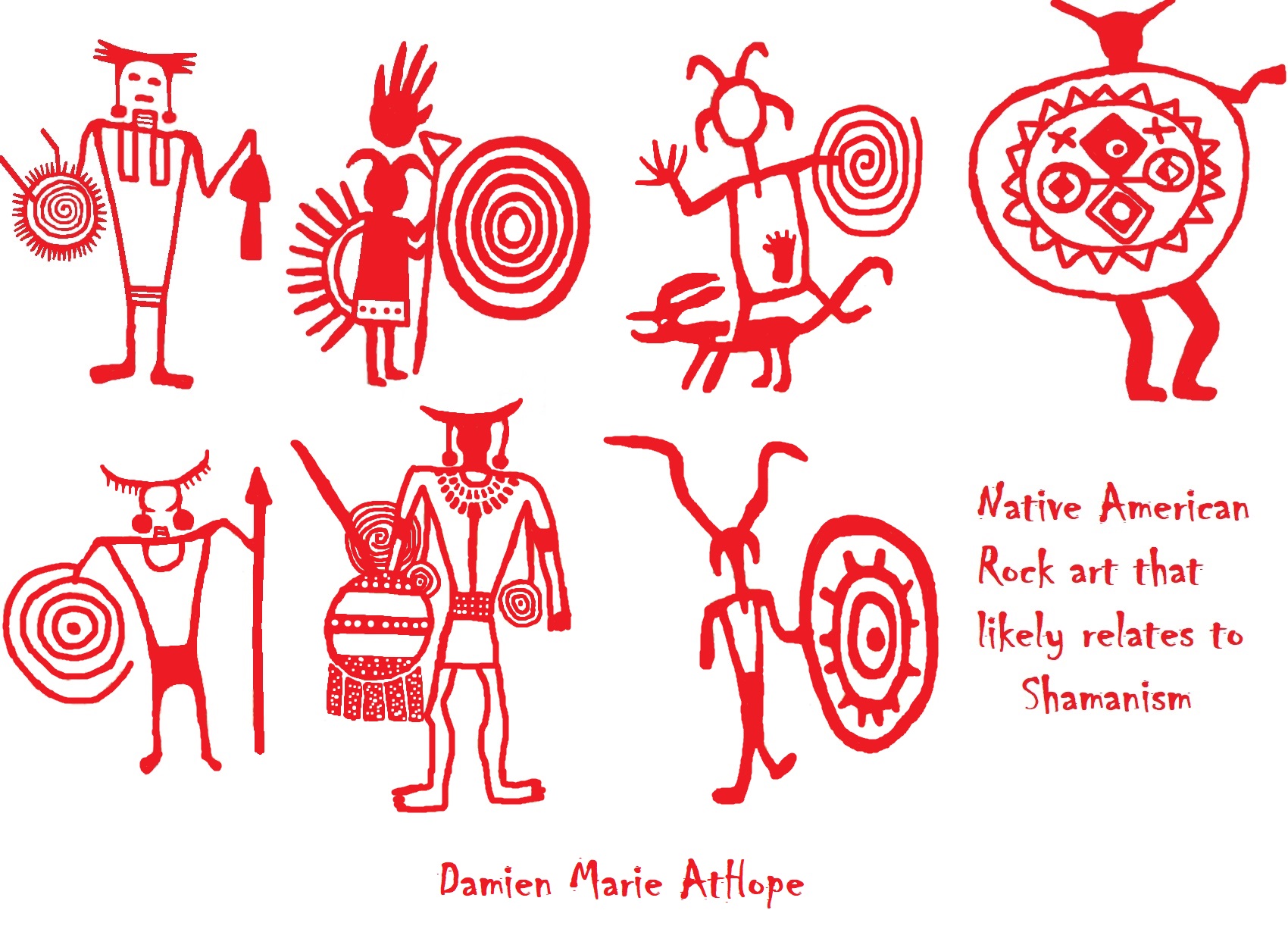
Shamanistic rock art 8,000 and 10,000 years ago from
central Aboriginal Siberians and Aboriginal drums in the Americas
Oldest Paleolithic Rock Art in Siberia between 8,000 and 10,000 years ago in the form of drawings of horses and bison scratched into rocks. Archaeologists are also hoping to find Paleolithic settlements or camps—traces of the people who left these drawings carved in stone. So far, who they were is entirely unknown. The drawings are at a site on the Ukok plateau on the Russian-Mongolian border near Kazakhstan where there is a modern tungsten-molybdenum mine, the Kalgutinskoye. There are more recent petroglyphs at the site. Researchers have run into problems in dating the Paleolithic-style drawings. But French researchers who studied the petroglyphs agree: They are even more ancient than previously believed, reports Siberian Times. Speaking to Siberian Times, an archaeologist specializing in Siberia, Dr. Lidia Zotkina, said:
We believe that we managed to prove that the petroglyphs were made in the Paleolithic era – and are the most ancient in Siberia. When the French archaeologists first arrived on the Ukok plateau and saw the petroglyphs they said: “If we had found them somewhere in France, we would not doubt they are Paleolithic, but here, in Siberia, we need to prove it.”’
The prehistoric people who drew the petroglyphs etched them onto glacier-polished rhyolite on horizontal planes. Rhyolite is a volcanic rock. The windy conditions on the Ukok plateau prevent scientists from obtaining a clear stratigraphy, or geological dating, of the rocks upon which the glyphs are drawn. Archaeologists also cannot use the usual archaeological methods of dating the drawings and will need to come up with new or innovative methods to determine how old they are. Also, Petroglyphs have been found in other areas of Siberia, such as these at Mount Baga-Zarya, Buryatia. Dr. Zotkina said. “According to the preliminary data, the glacier retreated as early as between 8,000 and 10,000 years ago. So that is when ancient people could access this place and create the petroglyphs.”
Siberian Times asked Dr. Zotkina who made the petroglyphs: “Some big Paleolithic sites where people must have lived were not found yet. The climate on Ukok does not help to preserve such sites, so we do not know who could make these petroglyphs, if it is correct that they are Paleolithic. But I think that it is a matter of the time. Sooner or later Paleolithic sites will be found and we will get more information about the people who could engrave these images.”
The Ukok Plateau also made the news last year with the famous Siberian Ice Maiden , whose reburial finally took place after years of requests. The Ice Maiden, also known as the Princess of Ukok, was put on display after she was discovered in 1993, drawing attention for the elaborate tattoos covering her body. However, many believed that it was indecent to expose her naked form to the public. That reasoning, combined with the increased flooding and earthquakes in the Altay region, created a strong desire to put her spirit to rest. Ancient nomadic tribes such as the Ket people and the Yugh people a separate but similar group lived along its banks. Shamanism among Kets shares characteristics with those of Turkic and Mongolic peoples thus not at all homogeneous in expression though neither is shamanism in Siberia in general. As for shamanism among Kets had several types of Ket shamans and shared characteristics with those of Turkic and Mongolic peoples.
Also, among Kets differing shamans was different sacral rites, power, and associated animals (deer or bear) and many other Siberian peoples like the Karagas who all seem to have a shared iconography using skeleton symbols. These skeleton symbols, could be a precursor to the later skull cult motivation in the fertile crescent, it may be bones of an helper animal or an ancestor used by a shaman, possibly joining the air and underwater worlds for a kind of shamanic rebirth expressed among some other Siberian cultures. The term “shamanism” which probably originates from the southwestern dialect derived from the Sym-Evenki peoples, connects to the Evenki word “Saman.”
The Evenki language has three large dialect groups: the northern, the southern and the eastern dialects formerly known as Tungus or Solon member of the northern group of Tungusic languages (“Tungusic” referring to the Evenks/Evenki Indigenous peoples of Siberia, Northeast China 56 ethnic groups/ Mongolia 535 ethnic groups referred to as Khamnigan; a Mongolic language spoken east of Lake Baikal in Russia, located in southern Siberia) and especially the Oroqen language.
The general area that is believed to be the native land of Evenki people involves a vast regions of Siberia between Lake Baikal and the Amur River. The Ewenki language forms the northern branch of the Manchu-Tungusic language group and is closely related to Even and Negidal in Siberia. Moreover, the term “shamanism” was first applied the ancient religion of the Turks, Mongols, Tungusic, and Samoyedic-speaking peoples but now describe even unrelated magico-religious practices in ethnic religions in Asia, Africa, Australasia and the Americas; which do to the seeming similarity in some themes and practices. The term Ket means “man” (plural understood as “men, people”) where a strictly organized patriarchal social system, thought to be the only survivors of an ancient nomadic people believed to have originally lived throughout central and southern Siberia descendants of the tribes of fishermen and hunters of the Yenisey taiga, who adopted some of the cultural ways of those original Ket-speaking tribes, who are suggested to be part of the Na-Dene language family represents a distinct migration of people from Asia to the New World.
Na-Dene languages seem likely to connect to the Yeniseian languages of central Siberia into a Dene–Yeniseian family proposed in a 2014 paper that the Na-Dene languages of North America seem to connect to the Yeniseian languages of central Siberia into a Dene–Yeniseian family as a common origin in a language spoken in Beringia, between the two continents. Na-Dene (Proto-Athabascan–Eyak–Tlingit) also his also been purposed to have a connection to Haida, thus seemingly linking several isolated languages between the Asian and North American continent spreading religious thought. The Athabaskan languages, thus could possibly connect with both Northern (mainly northern parts of North America) and Southern (mainly southern parts of North America) Athabaskan of Native languages in the Americas. Northern Athabaskan connected dialects seem to be associated with such indigenous speakers in Alberta, British Columbia, Manitoba, Northwest Territories, Nunavut, Saskatchewan, Yukon, Alaska, parts of Oregon, and northern California. and the American Southwest to northern Mexico. And in Southern Athabaskan or Apachean, and includes Apache and Navajo languages.
Furthermore, the origin of the Evenks seems to involve a complex mixing of different ancient aboriginal tribes from the north of Siberia with tribes related in language to the Turks and Mongols. The language of these tribes took precedence over the languages of the aboriginal population “Vasilevich” meaning the Tungusic languages aborigianals the Kets in Evenkia and Yukagirs in Yakutia. A chum (similar to a Native American “tipi”) came from Komi word “com” or Udmurt word “cum” which both mean “tent like shelter” is a temporary dwelling used by the nomadic Uralic people of northern Ural (Nenets, Nganasans, Enets, Khanty, Mansi, Komi) reindeer herders of northern/northwestern Siberia of and the Tyvan Todzhans of southern Siberia have a similar chum/tipi structure. The Evenks, Tungusic peoples, tribes, in Russia, the southernmost reindeer herders, of the Todzha region of the Republic of Tyva as well as their over-the-border relatives in northern Mongolia and China all use chums/tipis.
Around 115,000 to 15,000 years ago, Siberia was a time if glaciation generally consisting of a cold dry clement with tundra extending far south and some forest formations in the river valleys while an ice sheet covered area of Russia around the Ural Mountains that while some of the oldest mountains are more like large hills, and the area to the east of the lower Yenisei River basin, which in the general area of central and southern Siberia. Some of the first nomadic peoples entered Siberia about 50,000 years ago. The nomadic tribes Ket people Yugh people lived along the Yenisei River. The Yenisei basin originating Mongolia following north through central Siberia rock art images of shamans from the Middle Yenisci River flows north and the Middle lena River which flows northeast just 4 mi west of Lake Baikal that relatively connects to the Altai region, “Altai” means “Gold Mountain” there are images depicted on historical shamanic drums demonstrate a striking similarity with what is shown on the rock engravings. Images were painted on a drum·skin and served as symbols and sources of secret knowledge.
Some of the pairings on existing drums are almost exact duplicates of the images on the rocks seemingly demonstrates a possible relationship between the shaman and the decoration of drums in a shamans totem to help take them to other spheres of the universe, as another form of a protective covering that makes the drum noise of war animals and believed as a model of the universe itself embodying the ancestral connection to the owner of the drum and the female or male shaman him or herself drum owner. Some Siberian people perceived a drum as having once been a “female being” later transformed by a new ‘owner’, the shaman, who received the rights to the drum by undergoing a ceremonial marriage with the rocks (shamanistic rock art.
These images, perhaps have a relationship between the medicine weal symbol seen in some Native American cultures as a metaphor for a variety of spiritual concepts and was also made into stone monument that illustrates this shamans totem. Medicine (“medicine” denotes sacred) weal symbols (similar to a metaphor concept used by multiple Native Americans tribes) sacred hoop of life) where often constructed with stones circle and with internal spokes formed into a patterns on the ground on the ground oriented to the four directions. by several different Indigenous peoples in North America, especially those of the Plains nations. Seen as sacred architecture associated with religious ceremonies where the Circle of Life teachings are believed to promote the creation of knowledge through relationship building and take into consideration the four elements of being: physical, mental, spiritual, and emotional traditional drumming circles may also have a Circle of Life/ medicine weal symbiology achieving balance between these four elements. Stone medicine wheels are sited throughout the northern United States and southern Canada, specifically South Dakota, Wyoming, Montana, Alberta and Saskatchewan.
The majority of the approximately 70 documented stone structures still extant are in Alberta, Canada. Ceremonial Drums are painted with Hand drums as Aboriginal women hand-drumming practices has been an integral part of Aboriginal cultures likely far into prehistory where to some the drumbeat represents the a kind of heartbeat of Mother Earth and interestingly the North American Aboriginal cultures Ojibwe tradition suggests that, historically, drumming was predominantly the role of men, accept Ojibwe women traditionally used medicine drums, in particular the water drum. Water drums are used all over the world, including American Indian music made of various materials, with a membrane stretched over a pot. Water drumming is actually of African origin simplest form involves striking the surface of water directly with one’s hands. Aboriginal women had a hand drum to sing lullabies to their babies believing it helps the baby connect with its mother’s heart beat again as well as become connected to the spiritual culture.
The Painted Drum (a sacred Ojibwe drum) in traditional views surrounding Indigenous birthing and mother-child relationship ceremony. The story of the drum, is a traditional story a little girl brought the two nations together around the traditional drum as the Creator had explained to her, to play the drum together and unite the Mohawks and Ojibwe nation who before where always at war started to play, they played loud, and proud, providing Mother Earth’s heartbeat ending the waring. The drum may be seen in Siberia as one of the essential shamanic aubrites, of crucial assistance in attaining an altered state of conciseness. this ritual confirmed the drum as a living entity. and it was following this act that images were created on it. The painting of the drum-skin with different motifs thus completing the final action in the process of drum creation.
The drum and drumstick together there after became personal attributes of the shaman who then was believed to gain the ability to change the essence of things and (0 transform themselves into anything that the shaman might need in the course of his or her activities from things like a spiritual journey or during a struggle with the shaman’s enemies. Ancient nomadic tribes such as the Ket people and the Yugh people a separate but similar group lived along its banks. Shamanism among Kets shares characteristics with those of Turkic and Mongolic peoples thus not at all homogeneous in expression though neither is shamanism in Siberia in general. As for shamanism among Kets had several types of Ket shamans and shared characteristics with those of Turkic and Mongolic peoples. Also, among Kets differing shamans was different sacral rites, power, and associated animals (deer or bear) and many other Siberian peoples like the Karagas who all seem to have a shared iconography using skeleton symbols. These skeleton symbols, could be a precursor to the later skull cult motivation in the fertile crescent, it may be bones of an helper animal or an ancestor used by a shaman, possibly joining the air and underwater worlds for a kind of shamanic rebirth expressed among some other Siberian cultures.
The term “shamanism” which probably originates from the southwestern dialect derived from the Sym-Evenki peoples, connects to the Evenki word “Saman.” The Evenki language has three large dialect groups: the northern, the southern and the eastern dialects formerly known as Tungus or Solon member of the northern group of Tungusic languages (“Tungusic” referring to the Evenks/Evenki Indigenous peoples of Siberia, Northeast China 56 ethnic groups/ Mongolia 535 ethnic groups referred to as Khamnigan; a Mongolic language spoken east of Lake Baikal in Russia, located in southern Siberia) and especially the Oroqen language. The general area that is believed to be the native land of Evenki people involves a vast regions of Siberia between Lake Baikal and the Amur River. The Ewenki language forms the northern branch of the Manchu-Tungusic language group and is closely related to Even and Negidal in Siberia.
Moreover, the term “shamanism” was first applied the ancient religion of the Turks, Mongols, Tungusic, and Samoyedic-speaking peoples but now describe even unrelated magico-religious practices in ethnic religions in Asia, Africa, Australasia and the Americas; which do to the seeming similarity in some themes and practices. The term Ket means “man” (plural understood as “men, people”) where a strictly organized patriarchal social system, thought to be the only survivors of an ancient nomadic people believed to have originally lived throughout central and southern Siberia descendants of the tribes of fishermen and hunters of the Yenisey taiga, who adopted some of the cultural ways of those original Ket-speaking tribes, who are suggested to be part of the Na-Dene language family represents a distinct migration of people from Asia to the New World. Na-Dene languages seem likely to connect to the Yeniseian languages of central Siberia into a Dene–Yeniseian family proposed in a 2014 paper that the Na-Dene languages of North America seem to connect to the Yeniseian languages of central Siberia into a Dene–Yeniseian family as a common origin in a language spoken in Beringia, between the two continents. Na-Dene (Proto-Athabascan–Eyak–Tlingit) also his also been purposed to have a connection to Haida, thus seemingly linking several isolated languages between the Asian and North American continent spreading religious thought.
The Athabaskan languages, thus could possibly connect with both Northern (mainly northern parts of North America) and Southern (mainly southern parts of North America) Athabaskan of Native languages in the Americas. Northern Athabaskan connected dialects seem to be associated with such indigenous speakers in Alberta, British Columbia, Manitoba, Northwest Territories, Nunavut, Saskatchewan, Yukon, Alaska, parts of Oregon, and northern California. and the American Southwest to northern Mexico. And in Southern Athabaskan or Apachean, and includes Apache and Navajo languages. Furthermore, the origin of the Evenks seems to involve a complex mixing of different ancient aboriginal tribes from the north of Siberia with tribes related in language to the Turks and Mongols. The language of these tribes took precedence over the languages of the aboriginal population “Vasilevich” meaning the Tungusic languages aborigianals the Kets in Evenkia and Yukagirs in Yakutia. A chum (similar to a Native American “tipi”) came from Komi word “com” or Udmurt word “cum” which both mean “tent like shelter” is a temporary dwelling used by the nomadic Uralic people of northern Ural (Nenets, Nganasans, Enets, Khanty, Mansi, Komi) reindeer herders of northern/northwestern Siberia of and the Tyvan Todzhans of southern Siberia have a similar chum/tipi structure. The Evenks, Tungusic peoples, tribes, in Russia, the southernmost reindeer herders, of the Todzha region of the Republic of Tyva as well as their over-the-border relatives in northern Mongolia and China all use chums/tipis.
Around 115,000 to 15,000 years ago, Siberia was a time if glaciation generally consisting of a cold dry clement with tundra extending far south and some forest formations in the river valleys while an ice sheet covered area of Russia around the Ural Mountains that while some of the oldest mountains are more like large hills, and the area to the east of the lower Yenisei River basin, which in the general area of central and southern Siberia. Some of the first nomadic peoples entered Siberia about 50,000 years ago. The nomadic tribes Ket people Yugh people lived along the Yenisei River. The Yenisei basin originating Mongolia following north through central Siberia rock art images of shamans from the Middle Yenisci River flows north and the Middle lena River which flows northeast just 4 mi west of Lake Baikal that relatively connects to the Altai region, “Altai” means “Gold Mountain” there are images depicted on historical shamanic drums demonstrate a striking similarity with what is shown on the rock engravings. Images were painted on a drum·skin and served as symbols and sources of secret knowledge. Some of the pairings on existing drums are almost exact duplicates of the images on the rocks seemingly demonstrates a possible relationship between the shaman and the decoration of drums in a shamans totem to help take them to other spheres of the universe, as another form of a protective covering that makes the drum noise of war animals and believed as a model of the universe itself embodying the ancestral connection to the owner of the drum and the female or male shaman him or herself drum owner.
Some Siberian people perceived a drum as having once been a “female being” later transformed by a new ‘owner’, the shaman, who received the rights to the drum by undergoing a ceremonial marriage with the rocks (shamanistic rock art. These images, perhaps have a relationship between the medicine weal symbol seen in some Native American cultures as a metaphor for a variety of spiritual concepts and was also made into stone monument that illustrates this shamans totem. Medicine (“medicine” denotes sacred) weal symbols (similar to a metaphor concept used by multiple Native Americans tribes) sacred hoop of life) where often constructed with stones circle and with internal spokes formed into a patterns on the ground on the ground oriented to the four directions. by several different Indigenous peoples in North America, especially those of the Plains nations. Seen as sacred architecture associated with religious ceremonies where the Circle of Life teachings are believed to promote the creation of knowledge through relationship building and take into consideration the four elements of being: physical, mental, spiritual, and emotional traditional drumming circles may also have a Circle of Life/ medicine weal symbiology achieving balance between these four elements.
Stone medicine wheels are sited throughout the northern United States and southern Canada, specifically South Dakota, Wyoming, Montana, Alberta and Saskatchewan. The majority of the approximately 70 documented stone structures still extant are in Alberta, Canada. Ceremonial Drums are painted with Hand drums as Aboriginal women hand-drumming practices has been an integral part of Aboriginal cultures likely far into prehistory where to some the drumbeat represents the a kind of heartbeat of Mother Earth and interestingly the North American Aboriginal cultures Ojibwe tradition suggests that, historically, drumming was predominantly the role of men, accept Ojibwe women traditionally used medicine drums, in particular the water drum. Water drums are used all over the world, including American Indian music made of various materials, with a membrane stretched over a pot.
Water drumming is actually of African origin simplest form involves striking the surface of water directly with one’s hands. Aboriginal women had a hand drum to sing lullabies to their babies believing it helps the baby connect with its mother’s heart beat again as well as become connected to the spiritual culture. The Painted Drum (a sacred Ojibwe drum) in traditional views surrounding Indigenous birthing and mother-child relationship ceremony. The story of the drum, is a traditional story a little girl brought the two nations together around the traditional drum as the Creator had explained to her, to play the drum together and unite the Mohawks and Ojibwe nation who before where always at war started to play, they played loud, and proud, providing Mother Earth’s heartbeat ending the waring.
The drum may be seen in Siberia as one of the essential shamanic aubrites, of crucial assistance in attaining an altered state of conciseness. this ritual confirmed the drum as a living entity. and it was following this act that images were created on it. The painting of the drum-skin with different motifs thus completing the final action in the process of drum creation. The drum and drumstick together there after became personal attributes of the shaman who then was believed to gain the ability to change the essence of things and (0 transform themselves into anything that the shaman might need in the course of his or her activities from things like a spiritual journey or during a struggle with the shaman’s enemies.
- The Archaeology of Shamanism by Neil S. Price: https://books.google.com/books?id=ukpeAvyjHmIC&pg=PA47&lpg=PA47&dq=Yenisei+River+archaeology&source=bl&ots=4D83SC2vAl&sig=Gk6jxIJKS9FeLTs49ONGe51L9NM&hl=en&sa=X&ved=0ahUKEwiNxsTqjsbTAhULwGMKHSxWB5AQ6AEIMTAD#v=onepage&q=Yenisei%20River%20archaeology&f=false
- https://en.wikipedia.org/wiki/Seima-Turbino_phenomenon
- https://en.wikipedia.org/wiki/Altai_Mountains
- https://en.wikipedia.org/wiki/Lena_River
- https://en.wikipedia.org/wiki/Medicine_wheel
- http://www.naho.ca/jah/english/jah04_01/10HandDrumming_72-83.pdf
- https://en.wikipedia.org/wiki/Water_drum
- https://pdfs.semanticscholar.org/0f95/99204394fea990dcb2612cc2199f39c89f71.pdf
- http://ojibweresources.weebly.com/story-of-the-drum.html
- https://en.wikipedia.org/wiki/Prehistory_of_Siberia
- https://en.wikipedia.org/wiki/Na-Dene_languages
- https://en.wikipedia.org/wiki/Yenisei_River
- https://en.wikipedia.org/wiki/Shamanism
- https://en.wikipedia.org/wiki/Evenki_language
- https://en.wikipedia.org/wiki/Khamnigan_Mongol
- https://en.wikipedia.org/wiki/Evenks
- https://en.wikipedia.org/wiki/Chum_(tent)
- https://en.wikipedia.org/wiki/Lavvu
- https://www.archaeology.org/news/3536-150803-siberia-rock-art
- http://www.ancient-origins.net/news-history-archaeology/oldest-paleolithic-rock-art-siberia-may-be-more-ancient-previously-believed-020473
Sámi drum and its Art?
“A Sámi drum is a shamanic ceremonial drum used by the Sámi people of Northern Europe. Sámi ceremonial drums have two chiefly two variations, both oval-shaped: a bowl drum in which the drumhead is strapped over a burl, and a frame drum in which the drumhead stretches over a thin ring of bentwood. The drumhead is fashioned from reindeer hide. The patterns on the drum membrane reflect the worldview of the owner and his family, both in religious and worldly matters, such as reindeer herding, hunting, householding as well as relations to their neighbors and to the non-Sámi community.” ref
“In Sámi shamanism, the noaidi used the drum to get into a trance, or to obtain information from the future or other realms. The drum was held in one hand, and beaten with the other. While the noaidi was in trance, his “free spirit” was said to leave his body to visit the spiritual world. When applied for divination purposes, the drum was beaten together with a drum hammer and a vuorbi (‘index’ or ‘pointer’) made of brass or horn. Messages could be interpreted based on where the vuorbi stopped on the membrane, and at which symbols.” ref
“Drum art has either a Northern Sámi pattern, with several separate levels representing the different layers of spiritual worlds. Or a drum can have a typical Southern Sami decoration: a rhombus shaped sun symbol in the center, with other symbols around the sun, representing people, animals, landscape, and deities.” ref
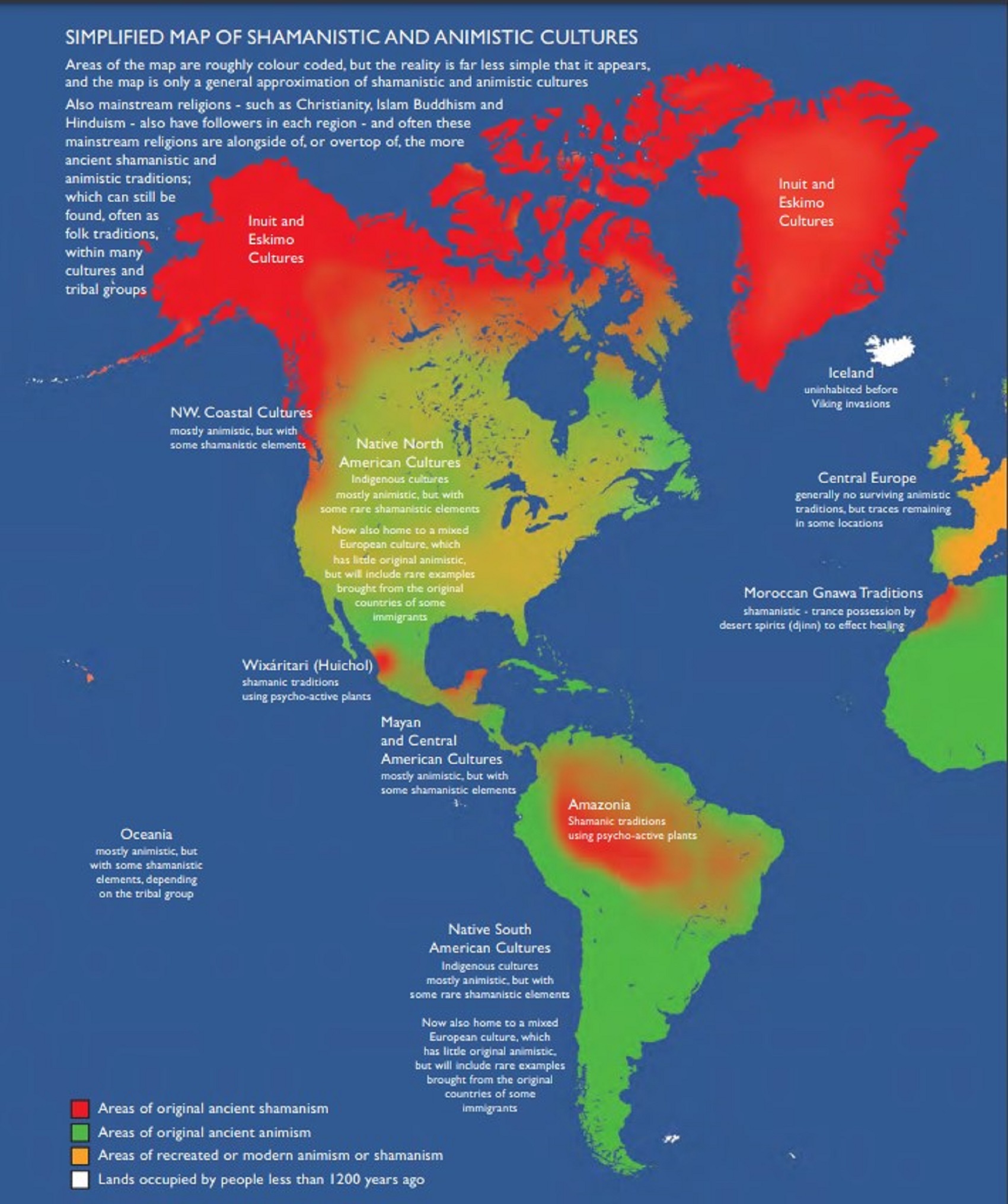
Pic ref
To get a very special low-cost subscription to Sacred Hoop – please visit: www.SacredHoop.org/offer.html
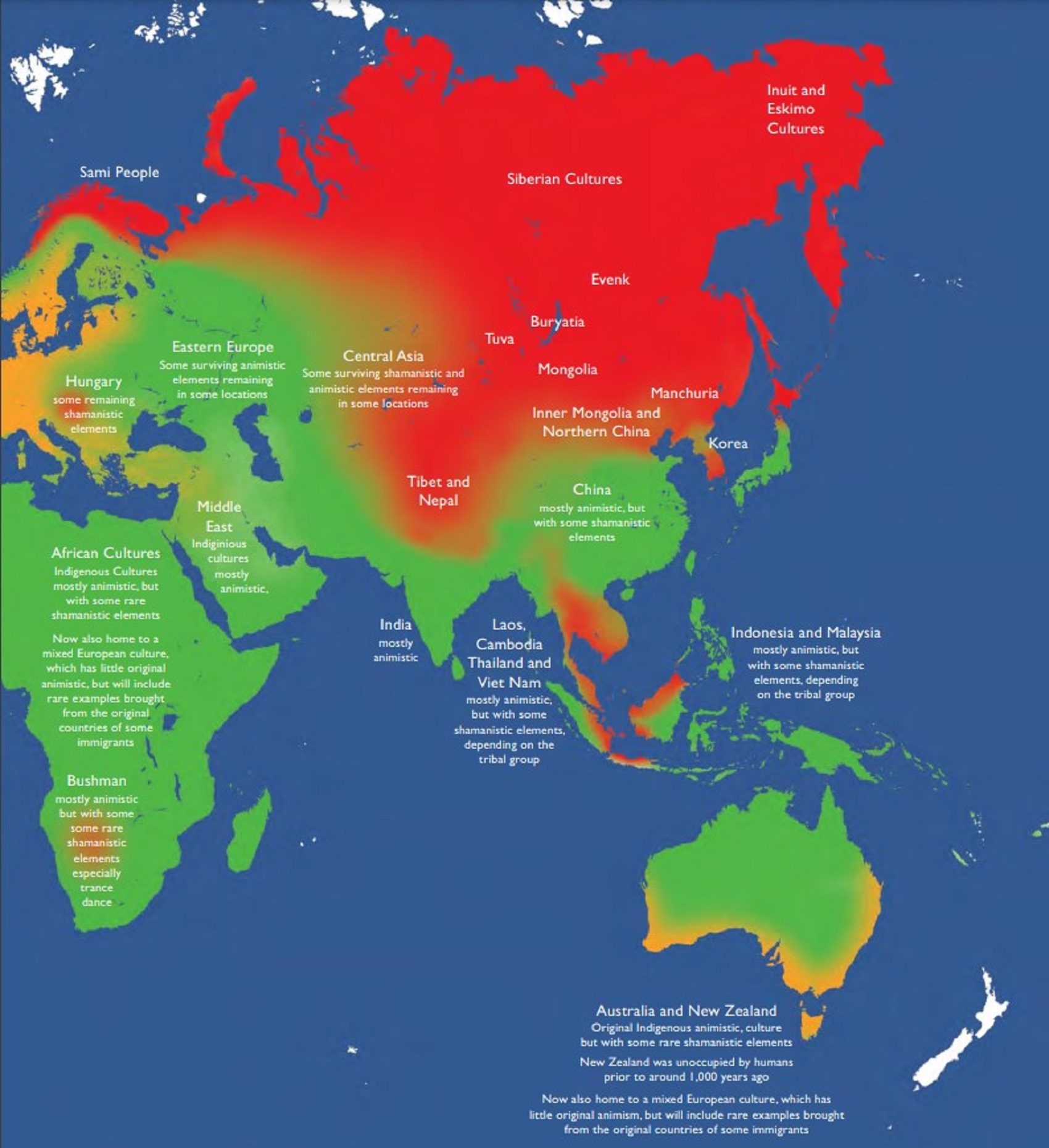
Pic ref
Reference from www.SacredHoop.org
SIMPLIFIED MAP OF SHAMANISTIC AND ANIMISTIC CULTURES
*Red is Areas of original ancient shamanism
*Green is Areas of original ancient animism
*Orange is Areas of recreated or modern animism or shamanism
Shamanism in Siberia
“A large minority of people in North Asia, particularly in Siberia, follow the religio-cultural practices of shamanism. Some researchers regard Siberia as the heartland of shamanism. The people of Siberia comprise a variety of ethnic groups, many of whom continue to observe shamanistic practices in modern times. Many classical ethnographers recorded the sources of the idea of “shamanism” among Siberian peoples. Siberian shamans’ spirit-journeys (reenacting their dreams wherein they had rescued the soul of the client) were conducted in, e.g., Oroch, Altai, and Nganasan healing séances.” ref
Terminology in Siberian languages
- ‘shaman’: saman (Nedigal, Nanay, Ulcha, Orok), sama (Manchu). The variant /šaman/ (i.e., pronounced “shaman”) is Evenk (whence it was borrowed into Russian).
- ‘shaman’: alman, olman, wolmen (Yukagir)
- ‘shaman’: [qam] (Tatar, Shor, Oyrat), [xam] (Tuva, Tofalar)
- The Buryat word for shaman is бөө (böö) [bøː], from early Mongolian böge.
- ‘shaman’: ńajt (Khanty, Mansi), from Proto-Uralic *nojta (c.f. Sámi noaidi)
- ‘shamaness’: [iduɣan] (Mongol), [udaɣan] (Yakut), udagan (Buryat), udugan (Evenki, Lamut), odogan (Nedigal). Related forms found in various Siberian languages include utagan, ubakan, utygan, utügun, iduan, or duana. All these are related to the Mongolian name of Etügen, the hearth goddess, and Etügen Eke ‘Mother Earth’. Maria Czaplicka points out that Siberian languages use words for male shamans from diverse roots, but the words for female shaman are almost all from the same root. She connects this with the theory that women’s practice of shamanism was established earlier than men’s, that “shamans were originally female.” ref
“As mentioned above, shamanistic practice shows great diversity, even if restricted to Siberia. In some cultures, the music or song related to shamanistic practice may mimic natural sounds, sometimes with onomatopoeia. This holds true for the practices of the noaidi among Sami groups. Although the Sami people live outside of Siberia, many of their shamanistic beliefs and practice shared important features with those of some Siberian cultures.” ref
“The joiks of the Sami were sung on shamanistic rites. Recently, joiks are sung in two different styles: one of these is sung only by young people; the traditional one may be the other, the “mumbling” style, which resembles magic spells. Several surprising characteristics of joiks can be explained by comparing the music ideals, as observed in joiks and contrasted to music ideals of other cultures. Some joiks intend to mimic natural sounds. This can be contrasted to bel canto, which intends to exploit human speech organs on the highest level to achieve an almost “superhuman” sound.” ref
“The intention to mimic natural sounds is present in some Siberian cultures as well: overtone singing, and also shamanic songs of some cultures can be examples:
- In a Soyot shamanic song, sounds of bird and wolf are imitated to represent helping spirits of the shaman.
- The seances of Nganasan shamans were accompanied by women imitating the sounds of the reindeer calf, (thought to provide fertility for those women). In 1931, A. Popov observed the Nganasan shaman Dyukhade Kosterkin imitating the sound of polar bear: the shaman was believed to have transformed into a polar bear.” ref
“Sound mimesis is not restricted to Siberian cultures and is not necessarily linked to shamanistic beliefs or practices. See, for example, Inuit throat singing, a game played by women, an example of Inuit music that employs overtone singing, and, in some cases, the imitation of natural sounds (mostly those of animals, e.g. geese). The imitation of animal sounds can also serve such practical reasons as luring game in hunt.” ref
“Uralic languages are proven to form a genealogical unit, a language family. Not all speakers of these languages live in Siberia or have shamanistic religions. The largest populations, the Hungarians and Finns, live outside Siberia and are mostly Christian. Saami people had kept shamanic practices alive for a long time. They live in Europe, but practiced shamanism until the 18th century. Most others (e.g. Hungarian, Finnic, Mari) have only remnant elements of shamanism. The majority lives outside Siberia. Some of them used to live in Siberia, but have migrated to their present locations since then.” ref
“The original location of the Proto-Uralic peoples (and its extent) is debated. Combined phytogeographical and linguistic considerations (distribution of various tree species and the presence of their names in various Uralic languages) suggest that this area was somewhere between the Kama and Vyatka rivers on the western side of the Ural Mountains.” ref
“Among several Samoyedic peoples shamanism was a living tradition also in modern times, especially at groups living in isolation until recent times (Nganasans). There were distinguished several types of shamans among Nenets, Enets, and Selkup people. (The Nganasan shaman used three different crowns, according to the situation: one for upper world, one for underneath word, one for occasion of childbirth.)” ref
Nenets people, Enets people, Nganasan people speak Northern Samoyedic languages. They live in North Siberia (Nenets live also in European parts), they provide classical examples. Selkups are the only ones who speak Southern Samoyedic languages nowadays. They live more to the south, shamanism was in decline also at the beginning of the 20th century, although folklore memories could be recorded even in the 1960s. Other Southern Samoyedic languages were spoken by some peoples living in the Sayan Mountains, but language shift has taken place, making all these languages extinct.
“The isolated location of Nganasan people enabled that shamanism was a living phenomenon among them even in the beginning of the 20th century, the last notable Nganasan shaman’s seances could be recorded on film in the 1970s. One of the occasions in which the shaman partook was the clean tent rite, held after the polar night, which included sacrifices.” ref
“Some peoples of the Sayan Mountains spoke once Southern Samoyedic languages. Most of them underwent a language shift in the beginning and middle of the 19th century, borrowing the language of neighboring Turkic peoples. The Kamassian language survived longer: 14 old people spoke it yet in 1914. In the late 20th century, some old people had passive or uncertain knowledge of the language, but collecting reliable scientific data was no longer possible. Today Kamassian is regarded as extinct.” ref
“The shamanism of Samoyedic peoples in the Sayan Mountains survived longer (if we regard Karagas as a Samoyedic people, although such approaches have been refined: the problem of their origin may be more complex). Diószegi Vilmos could record not only folklore memories in the late 1950s, but he managed also to talk personally to (no longer practicing) shamans, record their personal memories, songs, some of their paraphernalia.” ref
“Whether this shamanism is borrowed entirely from neighboring Turkic peoples, or whether it has some ethnic features, maybe remnants of Samoyedic origin, is unresolved. Comparative considerations suggest, that
- Karagas shamanism is affected by Abakan-Turkic and Buryat influence. Among the various Soyot cultures, the central Soyot groups, keeping cattle and horses, show Khalkha Mongol phenomena in their shamanism, the shamanism of Western Soyots, living on the steppe, is similar to that of Altai Turkic peoples. A shaman story narrates contacts between Soyots and Abakan Turkic peoples in a mythical form.
- Karagas and Eastern (reindeer-breeding, mountain-inhabiting) Soyots. have many similarities in their culture and shamanism. It was these two cultures who presented some ethnic features, phenomena lacking among neighboring Turkic peoples. E.g., the structure of their shamanic drum showed such peculiarity: it had two transoms. It was also these two cultures who showed some features, which could be possibly of Samoyedic origin: the shaman’s headdress, dress, and boots has the effigies symbolizing human organs, mostly bones; in the case of headdress, representation of human face. Also, the dress-initiating song of the Karagas shaman Kokuyev contained the expression “my shamanic dress with seven vertebrae”. Hoppál interprets the skeleton-like overlay of the Karagas shaman-dress as symbol of shamanic rebirth, similar remark applies for the skeleton-like iron ornamentation of the (not Samoyedic, but genealogically unclassified, Paleosiberian) Ket shamanic dress, although it may symbolize also the bones of the loon (the helper animal of the shaman). (The theory of Ket origin of the Karagas has already been mentioned above.) The skeleton-like overlay symbolized shamanic rebirth also among some other Siberian cultures.” ref
Hungarian Shamanism: Shamanistic remnants in Hungarian folklore
“Starting from the late 9th century onwards, the ancestors of the Hungarian people migrated from their Proto-Uralic homeland in Siberia to the Pannonian Basin, an area that includes present-day Hungary. Today, shamanism is no longer widely practiced by Hungarians, but elements of shamanism have been preserved in their folklore. Comparative methods reveal that some motifs used in folktales, fragments of songs, and folk rhymes retain aspects of the ancient belief system. In an effort to prove that shamanistic remnants existed within Hungarian folklore ethnographer, Diószegi Vilmos, compared ethnographic records of Hungarian and neighboring peoples, and works about various shamanic traditions of some Siberian peoples.” ref
“Mihály Hoppál continued Diószegi Vilmos’s work comparing shamanic beliefs of speakers of Uralic languages with those of several non-Uralic Siberian peoples. Although Ugrian folklore preserves many traces of shamanism, shamanism itself was a dying practice among the Khanty and Mansi people by the 1930s. Shamanism is still practiced by many indigenous peoples, but, among the modern Ugrians, shamanism is largely practiced by the Khanty.” ref
Turkic Shamanism: Turkic mythology
“Turkic peoples spread over large territories, and are far from alike. In some cases, shamanism has been widely amalgamated with Islam, in others with Buddhism, but there are surviving traditions among the Siberian Tatars, Tuvans, and Tofalar. The Altai Turks may be related to neighboring Ugrian, Samoyed, Ket, or Mongols. There may be also ethnographic traces of such past of these nowadays Turkic-speaking peoples of the Altai. For example, some of them have phallic-erotic fertility rites, and that can be compared to similar rites of Ugriansɮ.” ref

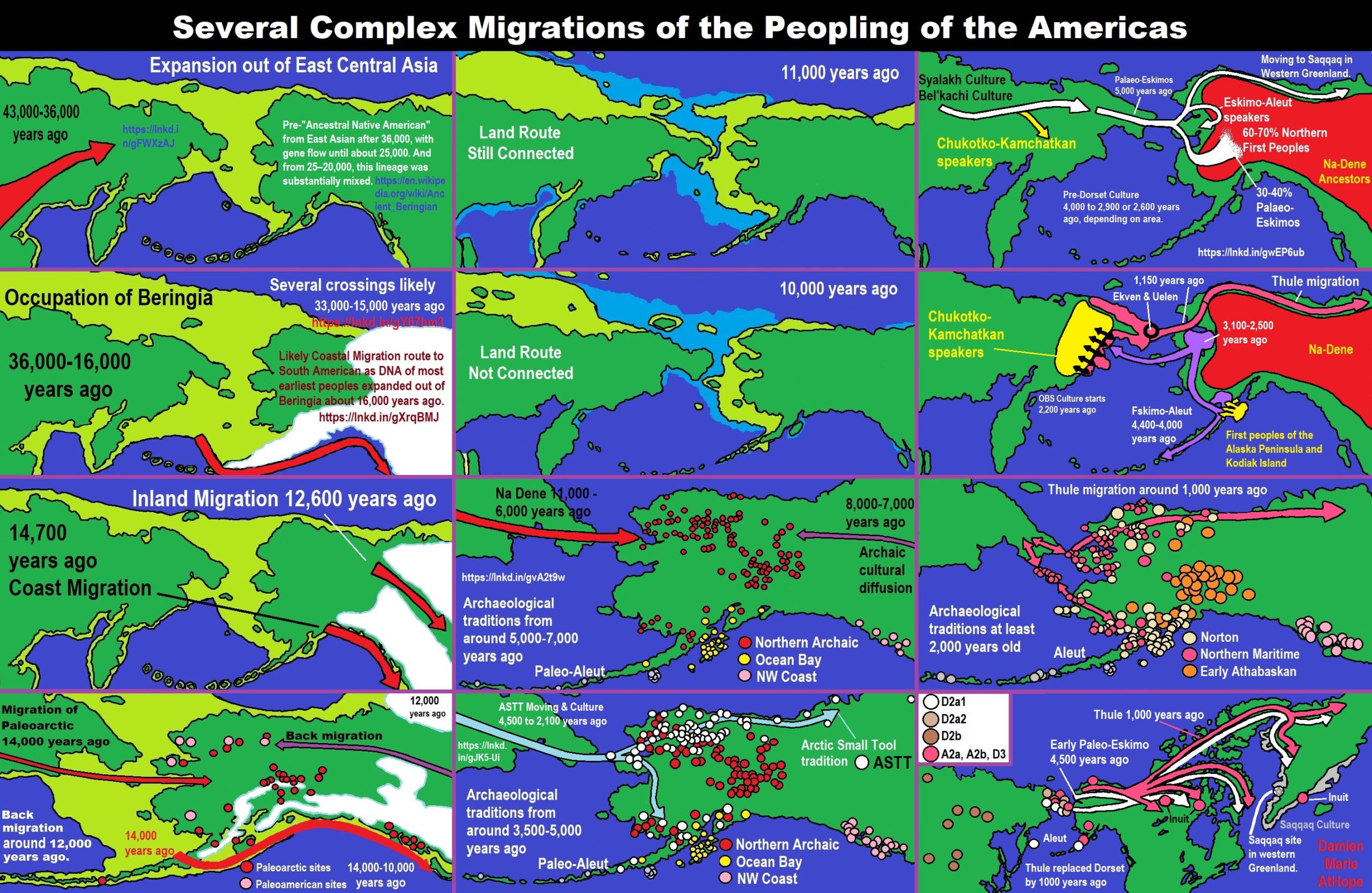
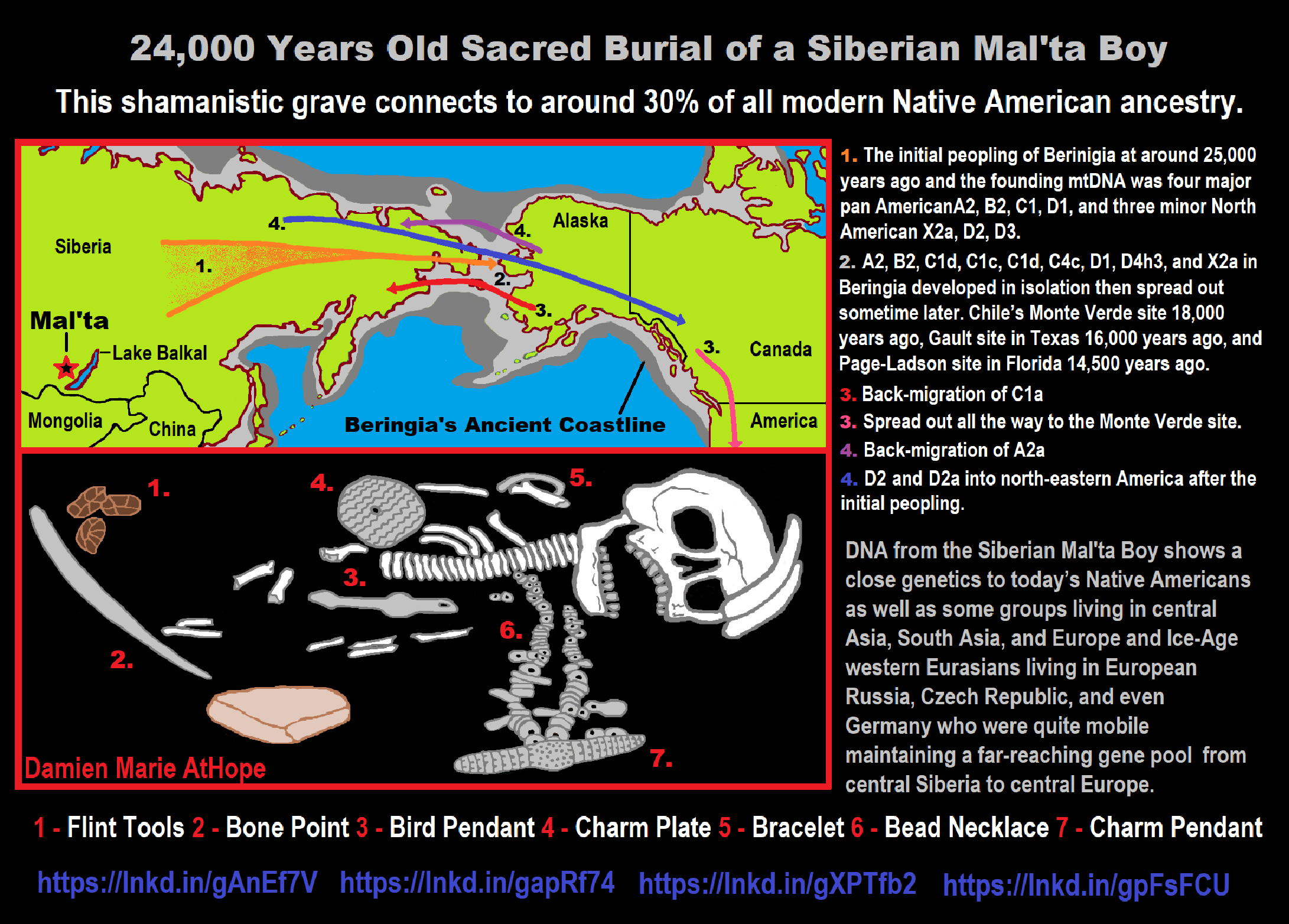
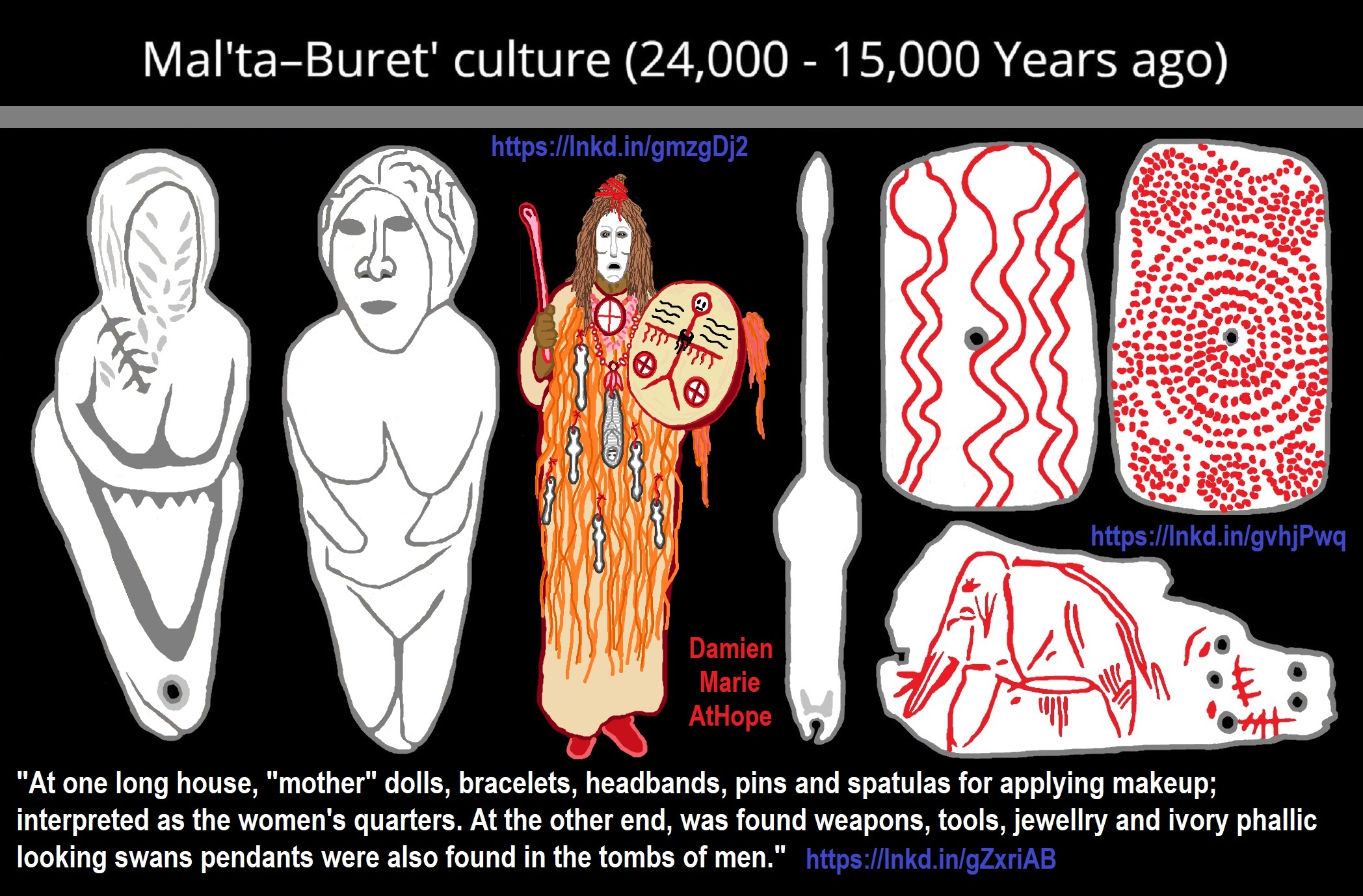





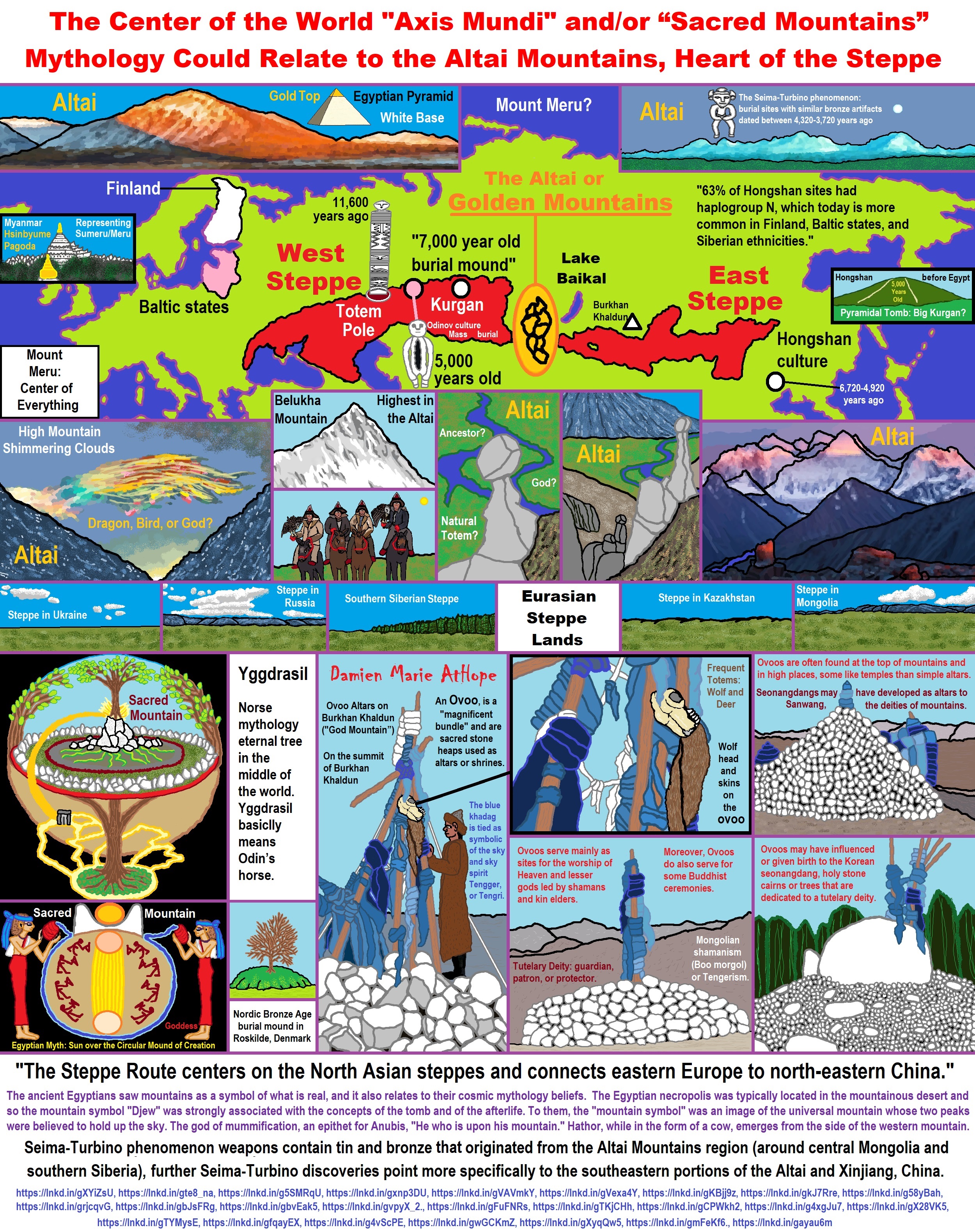

ref, ref, ref, ref, ref, ref, ref, ref, ref, ref, ref, ref, ref, ref, ref, ref, ref
“The shaman is, above all, a connecting figure, bridging several worlds for his people, traveling between this world, the underworld, and the heavens. He transforms himself into an animal and talks with ghosts, the dead, the deities, and the ancestors. He dies and revives. He brings back knowledge from the shadow realm, thus linking his people to the spirits and places which were once mythically accessible to all.–anthropologist Barbara Meyerhoff” ref


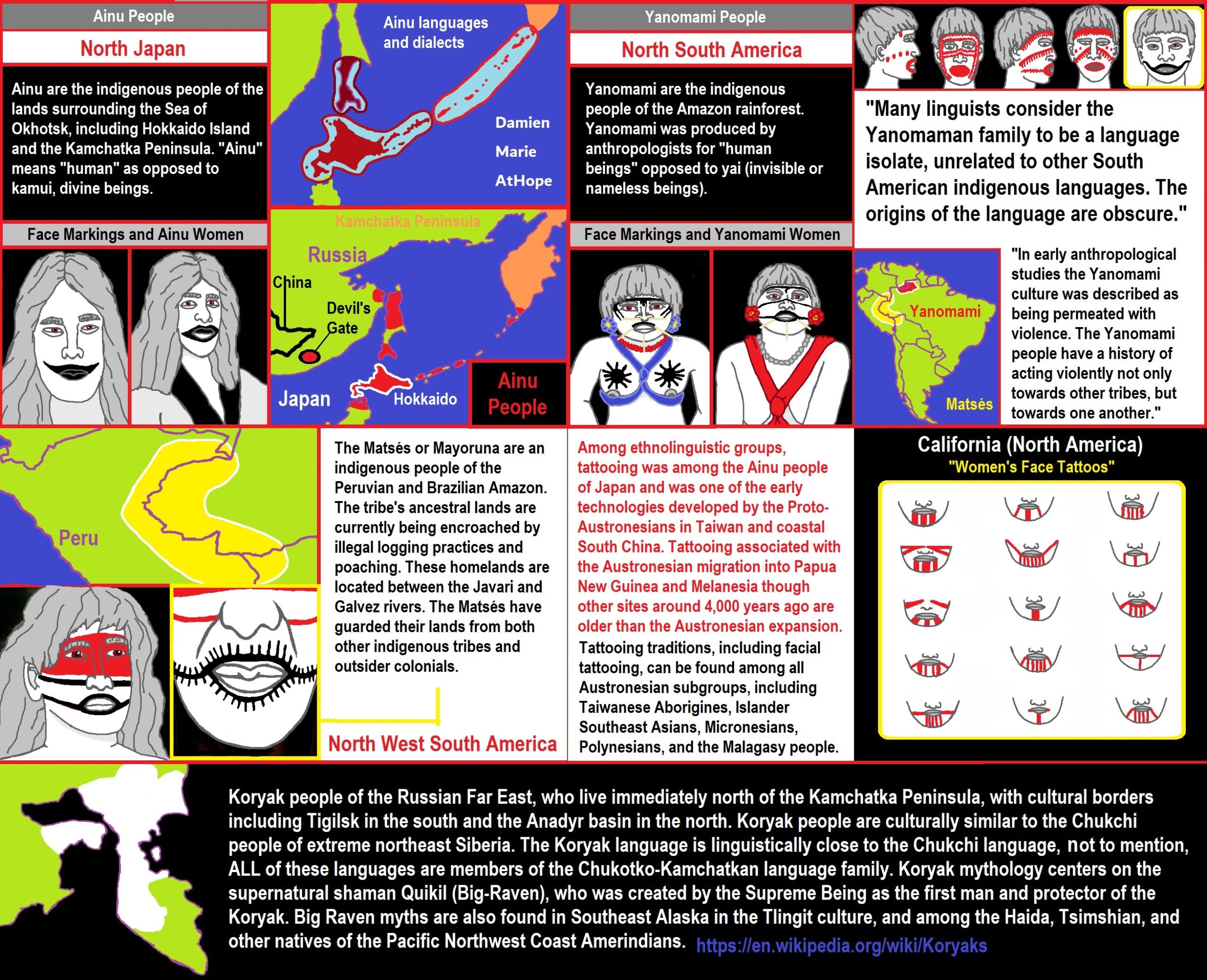
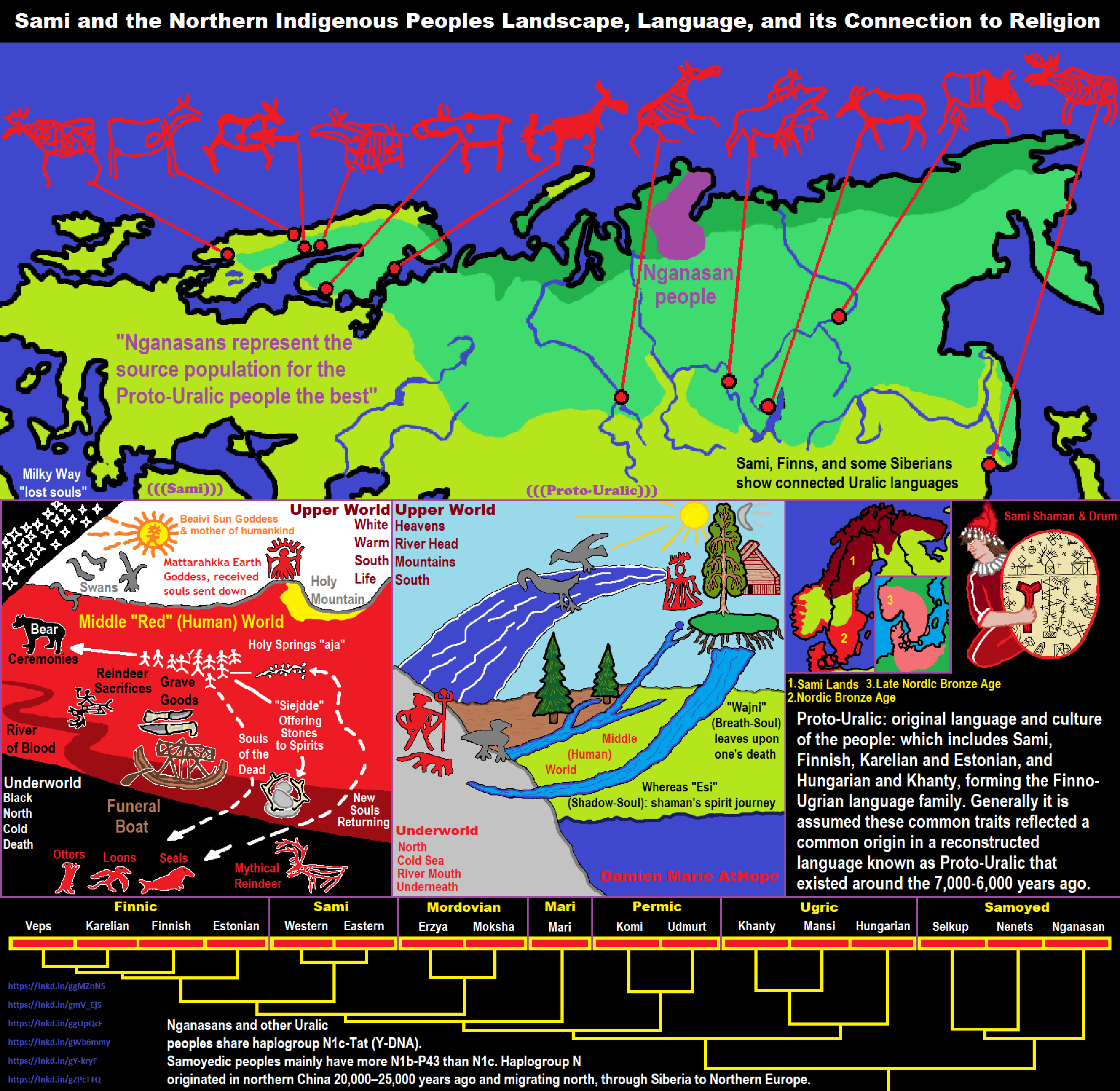

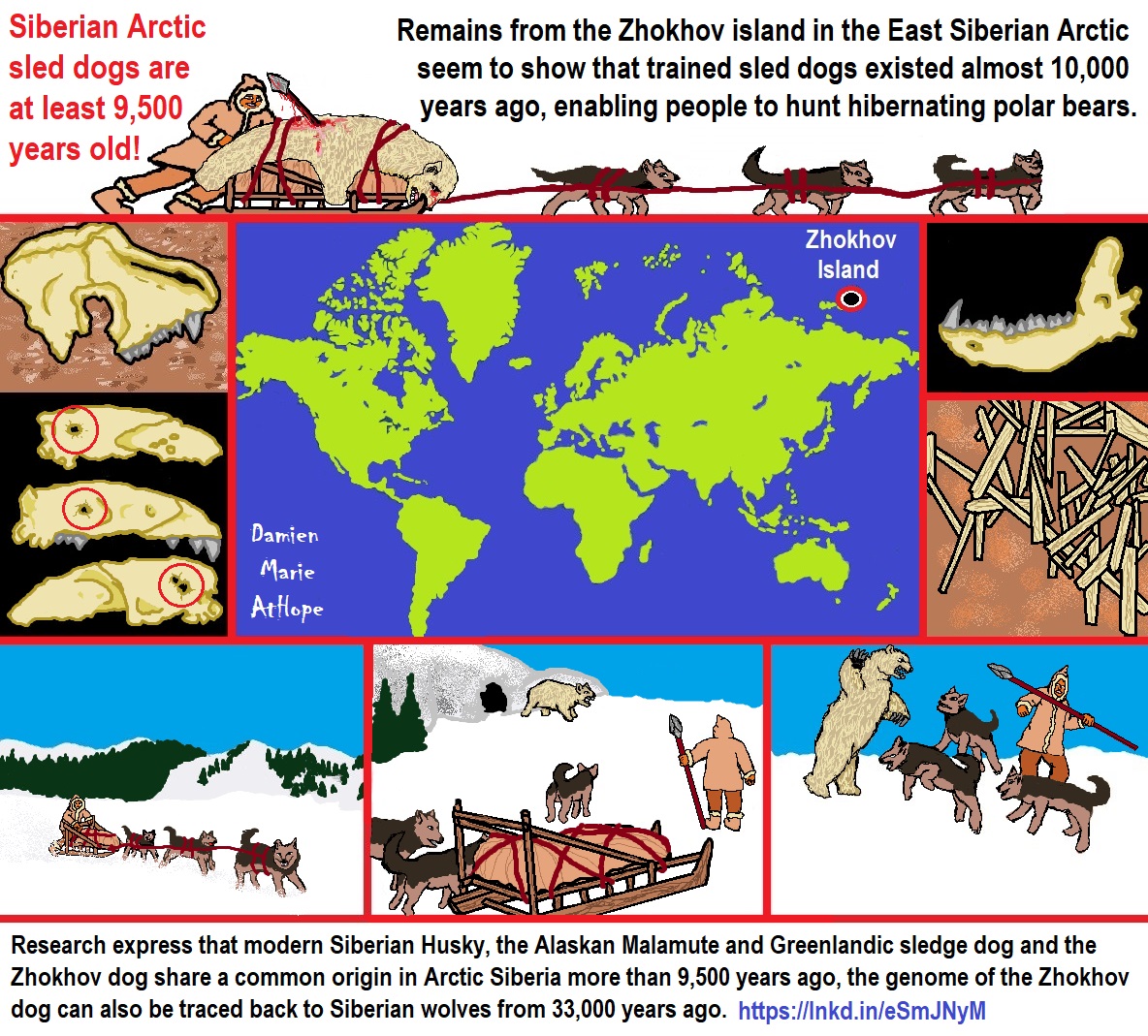

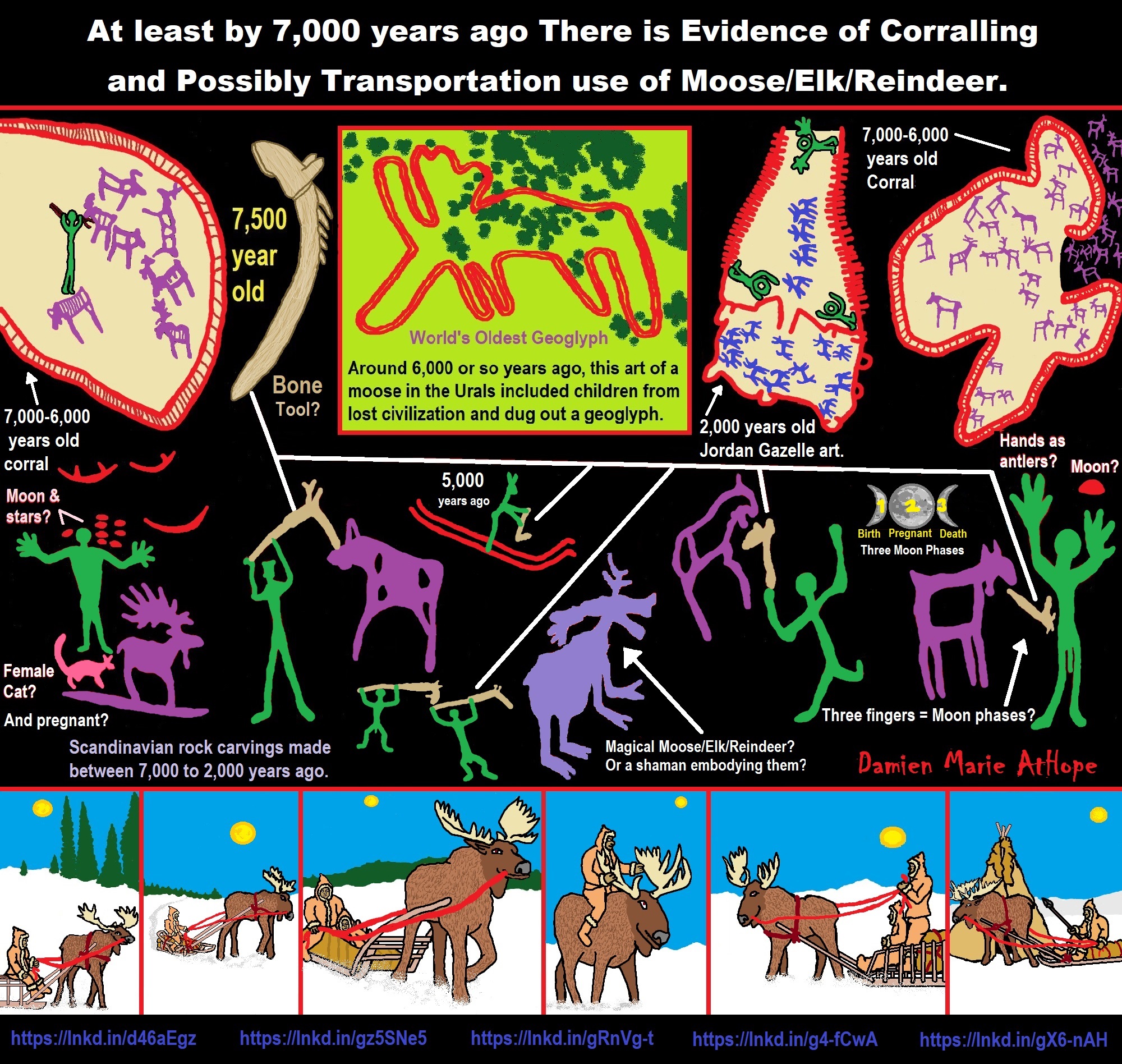
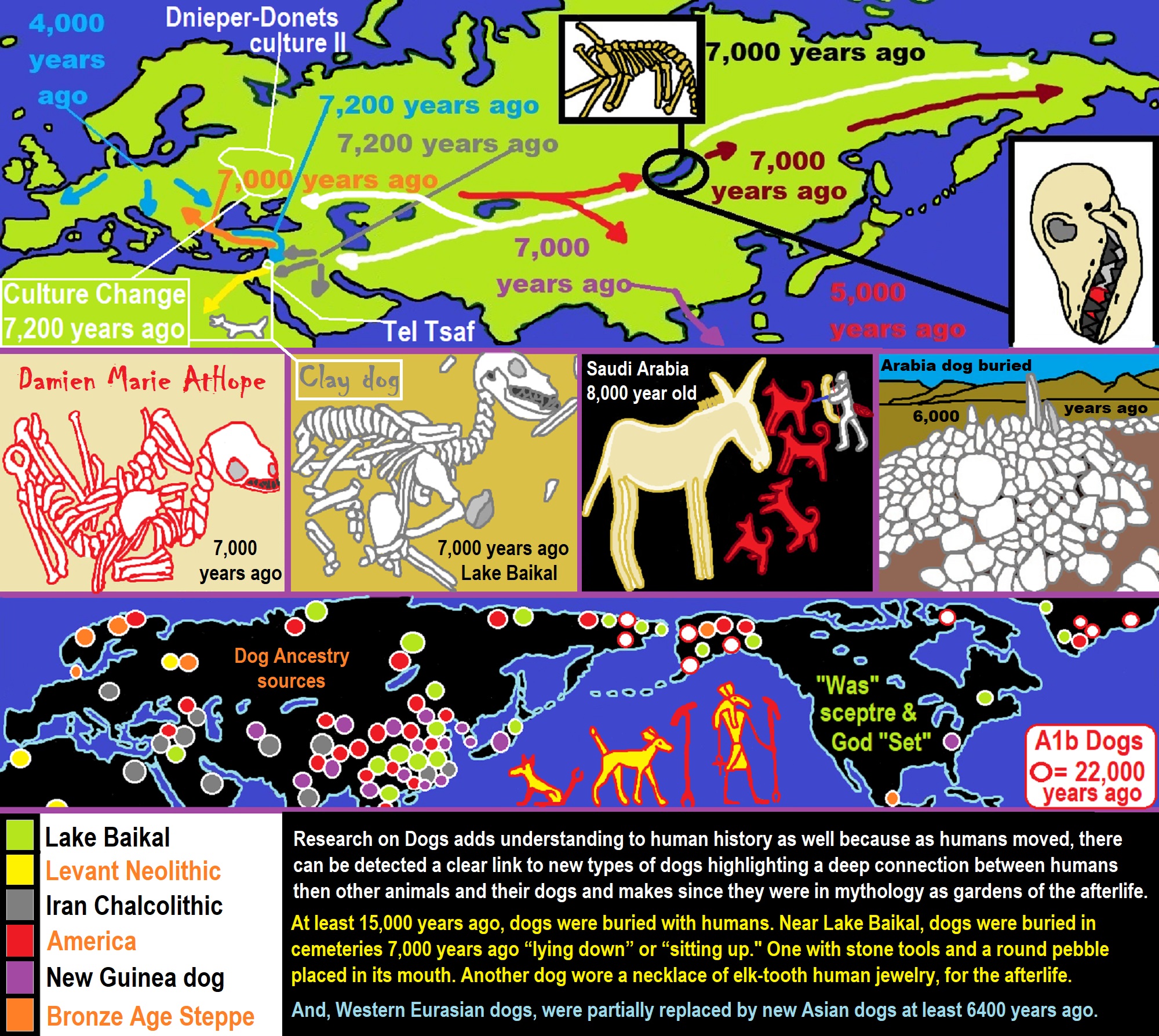
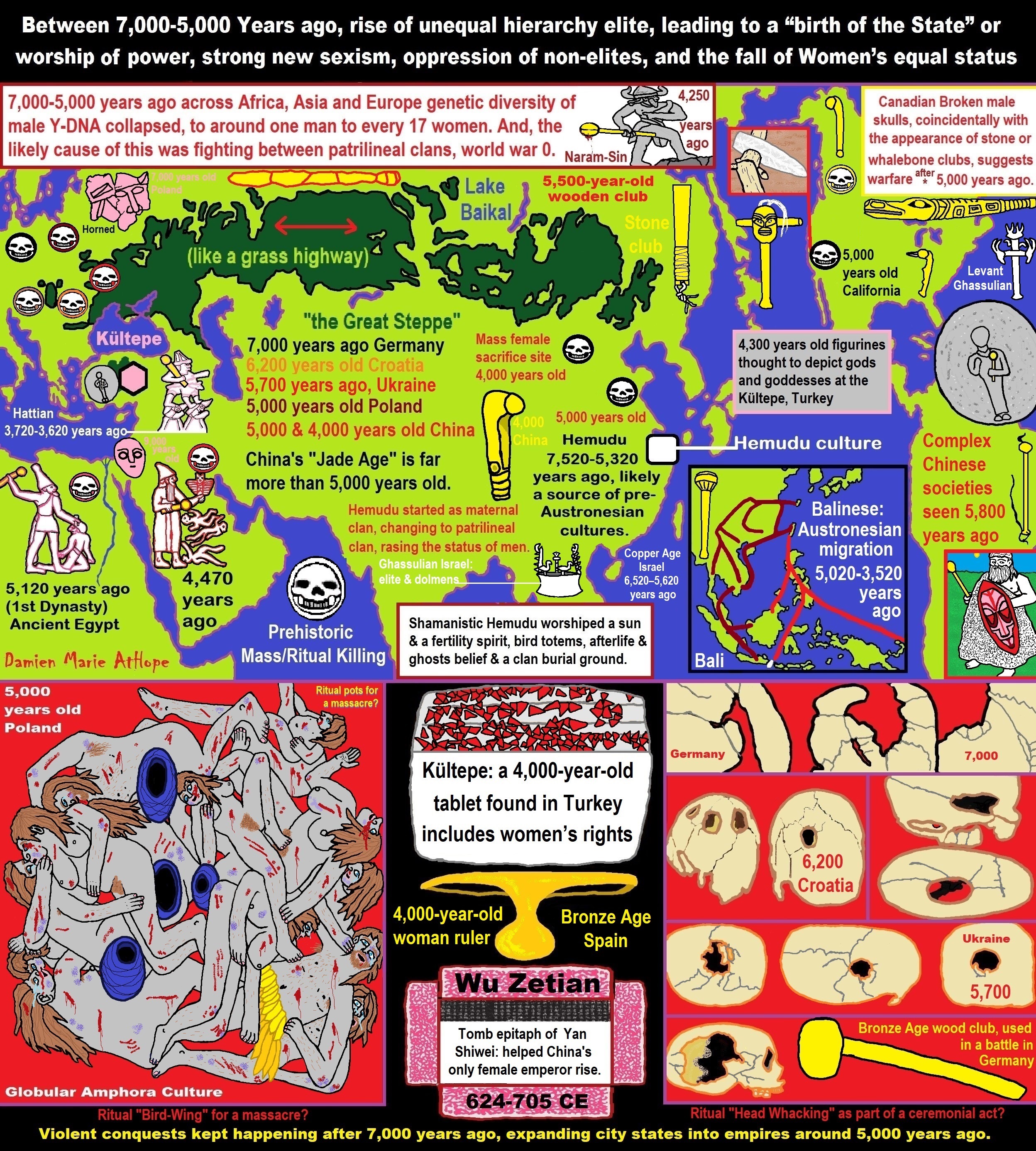
ref, ref, ref, ref, ref, ref, ref, ref, ref, ref, ref, ref, ref, ref, ref, ref, ref, ref, ref, ref, ref, ref, ref, ref, ref, ref, ref, ref, ref, ref, ref, ref, ref, ref, ref, ref, ref, ref, ref, ref, ref, ref, ref, ref, ref, ref, ref, ref, ref, ref, ref, ref, ref, ref, ref, ref, ref, ref, ref, ref, ref, ref, ref, ref, ref, ref, ref, ref, ref, ref, ref, ref, ref, ref, ref, ref, ref, ref, ref, ref, ref, ref, ref, ref, ref, ref, ref, ref, ref, ref
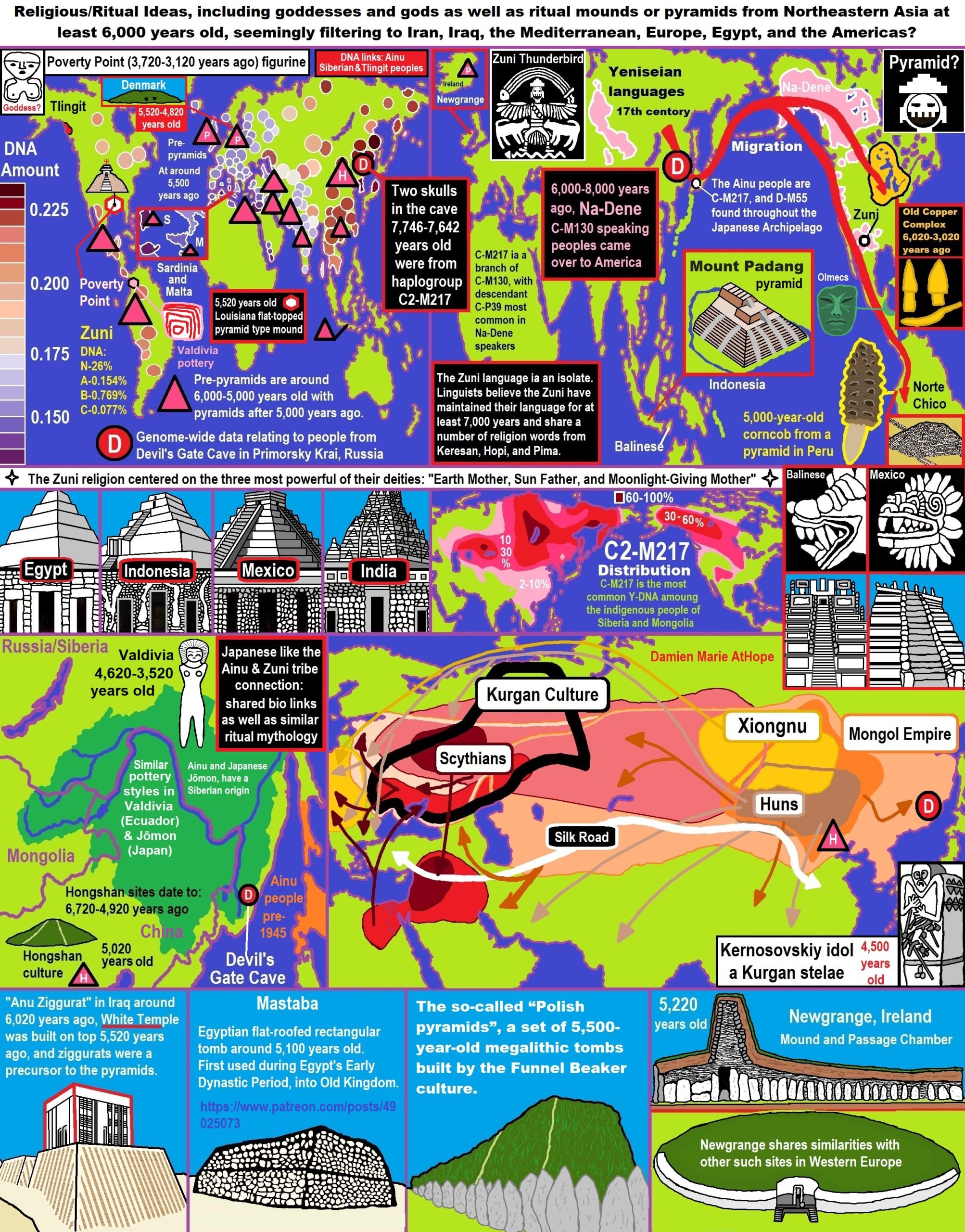

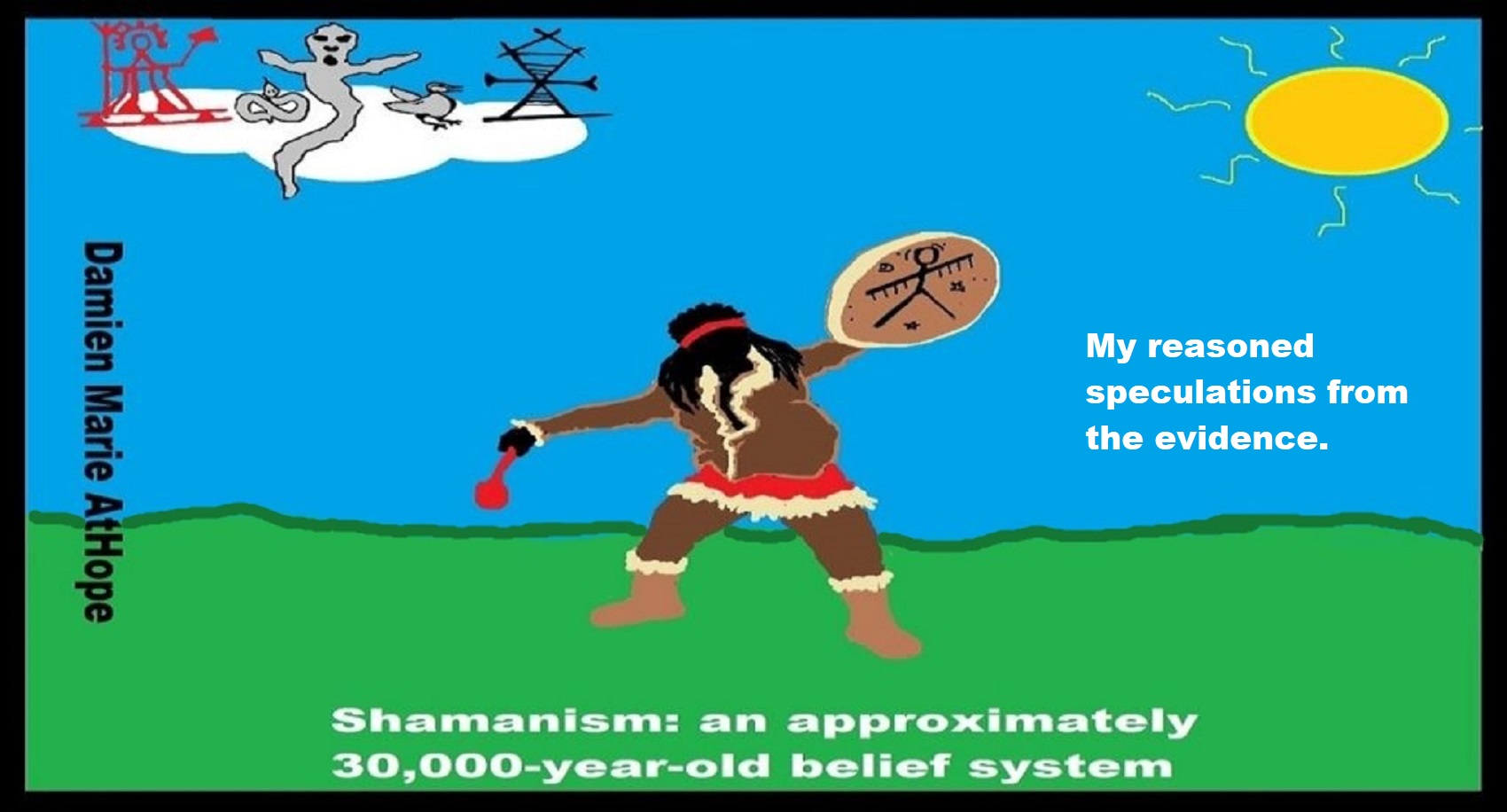
Shamanism (beginning around 30,000 years ago)
Shamanism (such as that seen in Siberia Gravettian culture: 30,000 years ago). Gravettian culture (34,000–24,000 years ago; Western Gravettian, mainly France, Spain, and Britain, as well as Eastern Gravettian in Central Europe and Russia. The eastern Gravettians, which include the Pavlovian culture). And, the Pavlovian culture (31,000 – 25,000 years ago such as in Austria and Poland). 31,000 – 20,000 years ago Oldest Shaman was Female, Buried with the Oldest Portrait Carving.
Shamanism is approximately a 30,000-year-old belief system and believe in spirit-filled life and/or afterlife that can be attached to or be expressed in things or objects and these objects can be used by special persons or in special rituals that can connect to spirit-filled life and/or afterlife. If you believe like this, regardless of your faith, you are a hidden shamanist.
Around 29,000 to 25,000 years ago in Dolní Vestonice, Czech Republic, the oldest human face representation is a carved ivory female head that was found nearby a female burial and belong to the Pavlovian culture, a variant of the Gravettian culture. The left side of the figure’s face was a distorted image and is believed to be a portrait of an elder female, who was around 40 years old. She was ritualistically placed beneath a pair of mammoth scapulae, one leaning against the other. Surprisingly, the left side of the skull was disfigured in the same manner as the aforementioned carved ivory figure, indicating that the figure was an intentional depiction of this specific individual. The bones and the earth surrounding the body contained traces of red ocher, a flint spearhead had been placed near the skull, and one hand held the body of a fox. This evidence suggests that this was the burial site of a shaman. This is the oldest site not only of ceramic figurines and artistic portraiture but also of evidence of early female shamans. Before 5,500 years ago, women were much more prominent in religion.
Archaeologists usually describe two regional variants: the western Gravettian, known namely from cave sites in France, Spain, and Britain, and the eastern Gravettian in Central Europe and Russia. The eastern Gravettians include the Pavlovian culture, which were specialized mammoth hunters and whose remains are usually found not in caves but in open air sites. The origins of the Gravettian people are not clear, they seem to appear simultaneously all over Europe. Though they carried distinct genetic signatures, the Gravettians and Aurignacians before them were descended from the same ancient founder population. According to genetic data, 37,000 years ago, all Europeans can be traced back to a single ‘founding population’ that made it through the last ice age. Furthermore, the so-called founding fathers were part of the Aurignacian culture, which was displaced by another group of early humans members of the Gravettian culture. Between 37,000 years ago and 14,000 years ago, different groups of Europeans were descended from a single founder population. To a greater extent than their Aurignacian predecessors, they are known for their Venus figurines. ref, ref, ref, ref, ref, ref, ref, ref, ref, ref, & ref
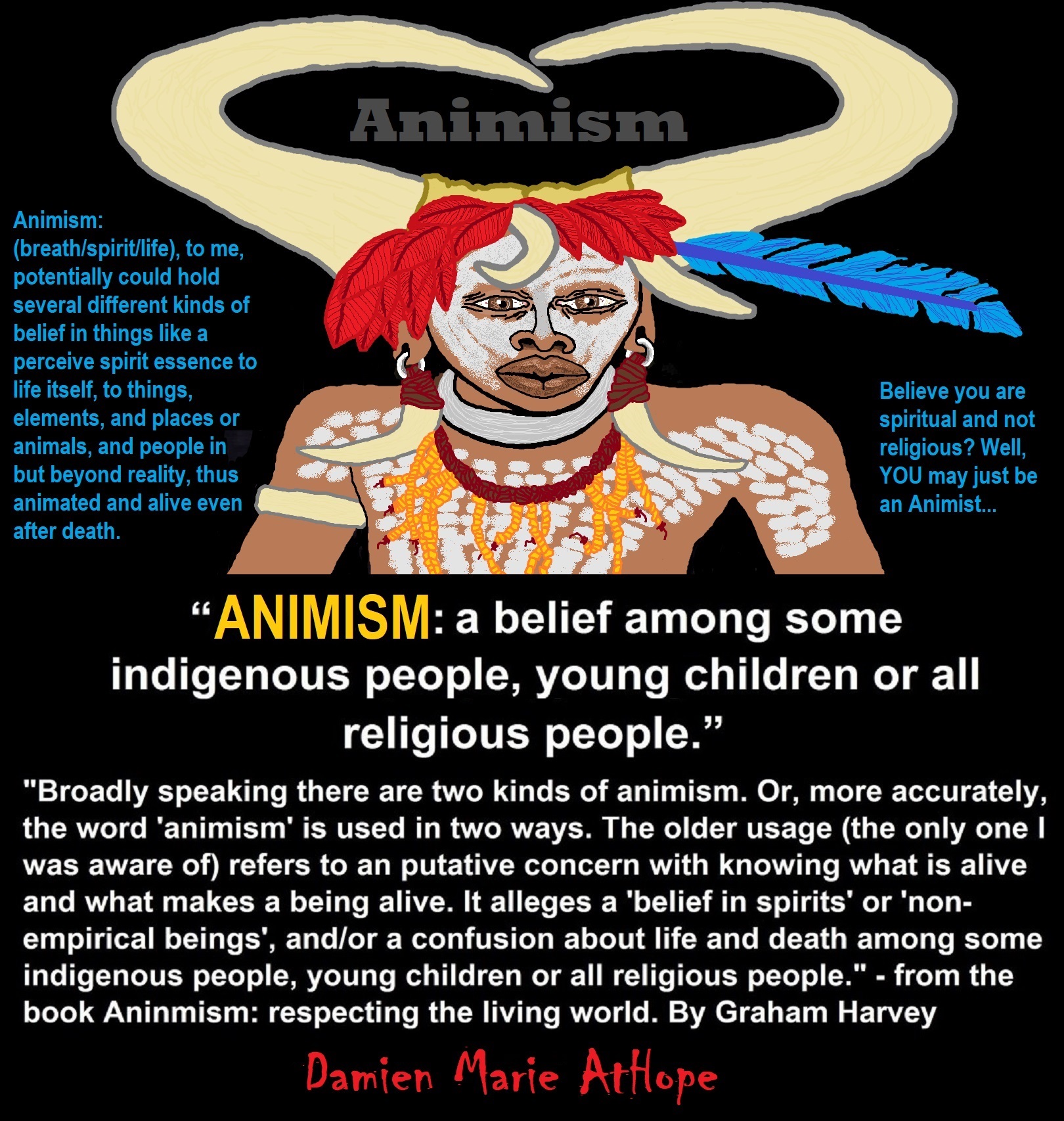
Animism: Respecting the Living World by Graham Harvey
“How have human cultures engaged with and thought about animals, plants, rocks, clouds, and other elements in their natural surroundings? Do animals and other natural objects have a spirit or soul? What is their relationship to humans? In this new study, Graham Harvey explores current and past animistic beliefs and practices of Native Americans, Maori, Aboriginal Australians, and eco-pagans. He considers the varieties of animism found in these cultures as well as their shared desire to live respectfully within larger natural communities. Drawing on his extensive casework, Harvey also considers the linguistic, performative, ecological, and activist implications of these different animisms.” ref


My thoughts on Religion Evolution with external links for more info:
- (Pre-Animism Africa mainly, but also Europe, and Asia at least 300,000 years ago), (Pre-Animism – Oxford Dictionaries)
- (Animism Africa around 100,000 years ago), (Animism – Britannica.com)
- (Totemism Europe around 50,000 years ago), (Totemism – Anthropology)
- (Shamanism Siberia around 30,000 years ago), (Shamanism – Britannica.com)
- (Paganism Turkey around 12,000 years ago), (Paganism – BBC Religion)
- (Progressed Organized Religion “Institutional Religion” Egypt around 5,000 years ago), (Ancient Egyptian Religion – Britannica.com)
- (CURRENT “World” RELIGIONS after 4,000 years ago) (Origin of Major Religions – Sacred Texts)
- (Early Atheistic Doubting at least by 2,600 years ago) (History of Atheism – Wikipedia)
“Religion is an Evolved Product” and Yes, Religion is Like Fear Given Wings…
Atheists talk about gods and religions for the same reason doctors talk about cancer, they are looking for a cure, or a firefighter talks about fires because they burn people and they care to stop them. We atheists too often feel a need to help the victims of mental slavery, held in the bondage that is the false beliefs of gods and the conspiracy theories of reality found in religions.
Understanding Religion Evolution:
- Pre-Animism (at least 300,000 years ago)
- Animism (Africa: 100,000 years ago)
- Totemism (Europe: 50,000 years ago)
- Shamanism (Siberia: 30,000 years ago)
- Paganism (Turkey: 12,000 years ago)
- Progressed organized religion (Egypt: 5,000 years ago), (Egypt, the First Dynasty 5,150 years ago)
- CURRENT “World” RELIGIONS (after 4,000 years ago)
- Early Atheistic Doubting (at least by 2,600 years ago)
“An Archaeological/Anthropological Understanding of Religion Evolution”
It seems ancient peoples had to survived amazing threats in a “dangerous universe (by superstition perceived as good and evil),” and human “immorality or imperfection of the soul” which was thought to affect the still living, leading to ancestor worship. This ancestor worship presumably led to the belief in supernatural beings, and then some of these were turned into the belief in gods. This feeble myth called gods were just a human conceived “made from nothing into something over and over, changing, again and again, taking on more as they evolve, all the while they are thought to be special,” but it is just supernatural animistic spirit-belief perceived as sacred.
Quick Evolution of Religion?
Pre-Animism (at least 300,000 years ago) pre-religion is a beginning that evolves into later Animism. So, Religion as we think of it, to me, all starts in a general way with Animism (Africa: 100,000 years ago) (theoretical belief in supernatural powers/spirits), then this is physically expressed in or with Totemism (Europe: 50,000 years ago) (theoretical belief in mythical relationship with powers/spirits through a totem item), which then enlists a full-time specific person to do this worship and believed interacting Shamanism (Siberia/Russia: 30,000 years ago) (theoretical belief in access and influence with spirits through ritual), and then there is the further employment of myths and gods added to all the above giving you Paganism (Turkey: 12,000 years ago) (often a lot more nature-based than most current top world religions, thus hinting to their close link to more ancient religious thinking it stems from). My hypothesis is expressed with an explanation of the building of a theatrical house (modern religions development). Progressed organized religion (Egypt: 5,000 years ago) with CURRENT “World” RELIGIONS (after 4,000 years ago).
Historically, in large city-state societies (such as Egypt or Iraq) starting around 5,000 years ago culminated to make religion something kind of new, a sociocultural-governmental-religious monarchy, where all or at least many of the people of such large city-state societies seem familiar with and committed to the existence of “religion” as the integrated life identity package of control dynamics with a fixed closed magical doctrine, but this juggernaut integrated religion identity package of Dogmatic-Propaganda certainly did not exist or if developed to an extent it was highly limited in most smaller prehistoric societies as they seem to lack most of the strong control dynamics with a fixed closed magical doctrine (magical beliefs could be at times be added or removed). Many people just want to see developed religious dynamics everywhere even if it is not. Instead, all that is found is largely fragments until the domestication of religion.
Religions, as we think of them today, are a new fad, even if they go back to around 6,000 years in the timeline of human existence, this amounts to almost nothing when seen in the long slow evolution of religion at least around 70,000 years ago with one of the oldest ritual worship. Stone Snake of South Africa: “first human worship” 70,000 years ago. This message of how religion and gods among them are clearly a man-made thing that was developed slowly as it was invented and then implemented peace by peace discrediting them all. Which seems to be a simple point some are just not grasping how devastating to any claims of truth when we can see the lie clearly in the archeological sites.
I wish people fought as hard for the actual values as they fight for the group/clan names political or otherwise they think support values. Every amount spent on war is theft to children in need of food or the homeless kept from shelter.
Here are several of my blog posts on history:
- To Find Truth You Must First Look
- (Magdalenian/Iberomaurusian) Connections to the First Paganists of the early Neolithic Near East Dating from around 17,000 to 12,000 Years Ago
- Natufians: an Ancient People at the Origins of Agriculture and Sedentary Life
- Possible Clan Leader/Special “MALE” Ancestor Totem Poles At Least 13,500 years ago?
- Jewish People with DNA at least 13,200 years old, Judaism, and the Origins of Some of its Ideas
- Baltic Reindeer Hunters: Swiderian, Lyngby, Ahrensburgian, and Krasnosillya cultures 12,020 to 11,020 years ago are evidence of powerful migratory waves during the last 13,000 years and a genetic link to Saami and the Finno-Ugric peoples.
- The Rise of Inequality: patriarchy and state hierarchy inequality
- Fertile Crescent 12,500 – 9,500 Years Ago: fertility and death cult belief system?
- 12,400 – 11,700 Years Ago – Kortik Tepe (Turkey) Pre/early-Agriculture Cultic Ritualism
- Ritualistic Bird Symbolism at Gobekli Tepe and its “Ancestor Cult”
- Male-Homosexual (female-like) / Trans-woman (female) Seated Figurine from Gobekli Tepe
- Could a 12,000-year-old Bull Geoglyph at Göbekli Tepe relate to older Bull and Female Art 25,000 years ago and Later Goddess and the Bull cults like Catal Huyuk?
- Sedentism and the Creation of goddesses around 12,000 years ago as well as male gods after 7,000 years ago.
- Alcohol, where Agriculture and Religion Become one? Such as Gobekli Tepe’s Ritualistic use of Grain as Food and Ritual Drink
- Neolithic Ritual Sites with T-Pillars and other Cultic Pillars
- Paganism: Goddesses around 12,000 years ago then Male Gods after 7,000 years ago
- First Patriarchy: Split of Women’s Status around 12,000 years ago & First Hierarchy: fall of Women’s Status around 5,000 years ago.
- Natufians: an Ancient People at the Origins of Agriculture and Sedentary Life
- J DNA and the Spread of Agricultural Religion (paganism)
- Paganism: an approximately 12,000-year-old belief system
- Paganism 12,000 years old: related to “Anarchism and Socialism” (Pre-Capitalism)
- Shaman burial in Israel 12,000 years ago and the Shamanism Phenomena
- Need to Mythicized: gods and goddesses
- 12,000 – 7,000 Years Ago – Paleo-Indian Culture (The Americas)
- 12,000 – 2,000 Years Ago – Indigenous-Scandinavians (Nordic)
- Norse did not wear helmets with horns?
- Pre-Pottery Neolithic Skull Cult around 11,500 to 8,400 Years Ago?
- 10,400 – 10,100 Years Ago, in Turkey the Nevail Cori Religious Settlement
- 9,000-6,500 Years Old Submerged Pre-Pottery/Pottery Neolithic Ritual Settlements off Israel’s Coast
- Catal Huyuk “first religious designed city” around 9,500 to 7,700 years ago (Turkey)
- Cultic Hunting at Catal Huyuk “first religious designed city”
- Special Items and Art as well as Special Elite Burials at Catal Huyuk
- New Rituals and Violence with the appearance of Pottery and People?
- Haplogroup N and its related Uralic Languages and Cultures
- Ainu people, Sámi people, Native Americans, the Ancient North Eurasians, and Paganistic-Shamanism with Totemism
- Ideas, Technology and People from Turkey, Europe, to China and Back again 9,000 to 5,000 years ago?
- First Pottery of Europe and the Related Cultures
- 9,000 years old Neolithic Artifacts Judean Desert and Hills Israel
- 9,000-7,000 years-old Sex and Death Rituals: Cult Sites in Israel, Jordan, and the Sinai
- 9,000-8500 year old Horned Female shaman Bad Dürrenberg Germany
- Neolithic Jewelry and the Spread of Farming in Europe Emerging out of West Turkey
- 8,600-year-old Tortoise Shells in Neolithic graves in central China have Early Writing and Shamanism
- Swing of the Mace: the rise of Elite, Forced Authority, and Inequality begin to Emerge 8,500 years ago?
- Migrations and Changing Europeans Beginning around 8,000 Years Ago
- My “Steppe-Anatolian-Kurgan hypothesis” 8,000/7,000 years ago
- Around 8,000-year-old Shared Idea of the Mistress of Animals, “Ritual” Motif
- Pre-Columbian Red-Paint (red ochre) Maritime Archaic Culture 8,000-3,000 years ago
- 7,522-6,522 years ago Linear Pottery culture which I think relates to Arcane Capitalism’s origins
- Arcane Capitalism: Primitive socialism, Primitive capital, Private ownership, Means of production, Market capitalism, Class discrimination, and Petite bourgeoisie (smaller capitalists)
- 7,500-4,750 years old Ritualistic Cucuteni-Trypillian culture of Moldova, Romania, and Ukraine
- Roots of a changing early society 7,200-6,700 years ago Jordan and Israel
- Agriculture religion (Paganism) with farming reached Britain between about 7,000 to 6,500 or so years ago and seemingly expressed in things like Western Europe’s Long Barrows
- My Thoughts on Possible Migrations of “R” DNA and Proto-Indo-European?
- “Millet” Spreading from China 7,022 years ago to Europe and related Language may have Spread with it leading to Proto-Indo-European
- Proto-Indo-European (PIE), ancestor of Indo-European languages: DNA, Society, Language, and Mythology
- The Dnieper–Donets culture and Asian varieties of Millet from China to the Black Sea region of Europe by 7,022 years ago
- Kurgan 6,000 years ago/dolmens 7,000 years ago: funeral, ritual, and other?
- 7,020 to 6,020-year-old Proto-Indo-European Homeland of Urheimat or proposed home of their Language and Religion
- Ancient Megaliths: Kurgan, Ziggurat, Pyramid, Menhir, Trilithon, Dolman, Kromlech, and Kromlech of Trilithons
- The Mytheme of Ancient North Eurasian Sacred-Dog belief and similar motifs are found in Indo-European, Native American, and Siberian comparative mythology
- Elite Power Accumulation: Ancient Trade, Tokens, Writing, Wealth, Merchants, and Priest-Kings
- Sacred Mounds, Mountains, Kurgans, and Pyramids may hold deep connections?
- Between 7,000-5,000 Years ago, rise of unequal hierarchy elite, leading to a “birth of the State” or worship of power, strong new sexism, oppression of non-elites, and the fall of Women’s equal status
- Paganism 7,000-5,000 years old: related to “Anarchism and Socialism” (Capitalism) (World War 0) Elite & their slaves
- Hell and Underworld mythologies starting maybe as far back as 7,000 to 5,000 years ago with the Proto-Indo-Europeans?
- The First Expression of the Male God around 7,000 years ago?
- White (light complexion skin) Bigotry and Sexism started 7,000 years ago?
- Around 7,000-year-old Shared Idea of the Divine Bird (Tutelary and/or Trickster spirit/deity), “Ritual” Motif
- Nekhbet an Ancient Egyptian Vulture Goddess and Tutelary Deity
- 6,720 to 4,920 years old Ritualistic Hongshan Culture of Inner Mongolia with 5,000-year-old Pyramid Mounds and Temples
- First proto-king in the Balkans, Varna culture around 6,500 years ago?
- 6,500–5,800 years ago in Israel Late Chalcolithic (Copper Age) Period in the Southern Levant Seems to Express Northern Levant Migrations, Cultural and Religious Transfer
- KING OF BEASTS: Master of Animals “Ritual” Motif, around 6,000 years old or older…
- Around 6000-year-old Shared Idea of the Solid Wheel & the Spoked Wheel-Shaped Ritual Motif
- “The Ghassulian Star,” a mysterious 6,000-year-old mural from Jordan; a Proto-Star of Ishtar, Star of Inanna or Star of Venus?
- Religious/Ritual Ideas, including goddesses and gods as well as ritual mounds or pyramids from Northeastern Asia at least 6,000 years old, seemingly filtering to Iran, Iraq, the Mediterranean, Europe, Egypt, and the Americas?
- Maykop (5,720–5,020 years ago) Caucasus region Bronze Age culture-related to Copper Age farmers from the south, influenced by the Ubaid period and Leyla-Tepe culture, as well as influencing the Kura-Araxes culture
- 5-600-year-old Tomb, Mummy, and First Bearded Male Figurine in a Grave
- Kura-Araxes Cultural 5,520 to 4,470 years old DNA traces to the Canaanites, Arabs, and Jews
- Minoan/Cretan (Keftiu) Civilization and Religion around 5,520 to 3,120 years ago
- Evolution Of Science at least by 5,500 years ago
- 5,500 Years old birth of the State, the rise of Hierarchy, and the fall of Women’s status
- “Jiroft culture” 5,100 – 4,200 years ago and the History of Iran
- Stonehenge: Paganistic Burial and Astrological Ritual Complex, England (5,100-3,600 years ago)
- Around 5,000-year-old Shared Idea of the “Tree of Life” Ritual Motif
- Complex rituals for elite, seen from China to Egypt, at least by 5,000 years ago
- Around 5,000 years ago: “Birth of the State” where Religion gets Military Power and Influence
- The Center of the World “Axis Mundi” and/or “Sacred Mountains” Mythology Could Relate to the Altai Mountains, Heart of the Steppe
- Progressed organized religion starts, an approximately 5,000-year-old belief system
- China’s Civilization between 5,000-3,000 years ago, was a time of war and class struggle, violent transition from free clans to a Slave or Elite society
- Origin of Logics is Naturalistic Observation at least by around 5,000 years ago.
- Paganism 5,000 years old: progressed organized religion and the state: related to “Anarchism and Socialism” (Kings and the Rise of the State)
- Ziggurats (multi-platform temples: 4,900 years old) to Pyramids (multi-platform tombs: 4,700 years old)
- Did a 4,520–4,420-year-old Volcano In Turkey Inspire the Bible God?
- Finland’s Horned Shaman and Pre-Horned-God at least 4,500 years ago?
- 4,000-year-Old Dolmens in Israel: A Connected Dolmen Religious Phenomenon?
- Creation myths: From chaos, Ex nihilo, Earth-diver, Emergence, World egg, and World parent
- Bronze Age “Ritual” connections of the Bell Beaker culture with the Corded Ware/Single Grave culture, which were related to the Yamnaya culture and Proto-Indo-European Languages/Religions
- Low Gods (Earth/ Tutelary deity), High Gods (Sky/Supreme deity), and Moralistic Gods (Deity enforcement/divine order)
- The exchange of people, ideas, and material-culture including, to me, the new god (Sky Father) and goddess (Earth Mother) religion between the Cucuteni-Trypillians and others which is then spread far and wide
- Koryaks: Indigenous People of the Russian Far East and Big Raven myths also found in Tlingit, Haida, Tsimshian, and other Indigenous People of North America
- 42 Principles Of Maat (Egyptian Goddess of the justice) around 4,400 years ago, 2000 Years Before Ten Commandments
- “Happy Easter” Well Happy Eostre/Ishter
- 4,320-3,820 years old “Shimao” (North China) site with Totemistic-Shamanistic Paganism and a Stepped Pyramid
- 4,250 to 3,400 Year old Stonehenge from Russia: Arkaim?
- 4,100-year-old beaker with medicinal & flowering plants in a grave of a woman in Scotland
- Early European Farmer ancestry, Kelif el Boroud people with the Cardial Ware culture, and the Bell Beaker culture Paganists too, spread into North Africa, then to the Canary Islands off West Africa
- Flood Accounts: Gilgamesh epic (4,100 years ago) Noah in Genesis (2,600 years ago)
- Paganism 4,000 years old: related to “Anarchism and Socialism” (First Moralistic gods, then the Origin time of Monotheism)
- When was the beginning: TIMELINE OF CURRENT RELIGIONS, which start around 4,000 years ago.
- Early Religions Thought to Express Proto-Monotheistic Systems around 4,000 years ago
- Kultepe? An archaeological site with a 4,000 years old women’s rights document.
- Single God Religions (Monotheism) = “Man-o-theism” started around 4,000 years ago with the Great Sky Spirit/God Tiān (天)?
- Confucianism’s Tiān (Shangdi god 4,000 years old): Supernaturalism, Pantheism or Theism?
- Yes, Your Male God is Ridiculous
- Mythology, a Lunar Deity is a Goddess or God of the Moon
- Sacred Land, Hills, and Mountains: Sami Mythology (Paganistic Shamanism)
- Horse Worship/Sacrifice: mythical union of Ruling Elite/Kingship and the Horse
- The Amorite/Amurru people’s God Amurru “Lord of the Steppe”, relates to the Origins of the Bible God?
- Bronze Age Exotic Trade Routes Spread Quite Far as well as Spread Religious Ideas with Them
- Sami and the Northern Indigenous Peoples Landscape, Language, and its Connection to Religion
- Prototype of Ancient Analemmatic Sundials around 3,900-3,150 years ago and a Possible Solar Connection to gods?
- Judaism is around 3,450 or 3,250 years old. (“Paleo-Hebrew” 3,000 years ago and Torah 2,500 years ago)
- The Weakening of Ancient Trade and the Strengthening of Religions around 3000 years ago?
- Are you aware that there are religions that worship women gods, explain now religion tears women down?
- Animistic, Totemistic, and Paganistic Superstition Origins of bible god and the bible’s Religion.
- Myths and Folklore: “Trickster gods and goddesses”
- Jews, Judaism, and the Origins of Some of its Ideas
- An Old Branch of Religion Still Giving Fruit: Sacred Trees
- Dating the BIBLE: naming names and telling times (written less than 3,000 years ago, provable to 2,200 years ago)
- Did a Volcano Inspire the bible god?
- The Amorite/Amurru people’s God Amurru “Lord of the Steppe”, relates to the Origins of the Bible God?
- Dené–Yeniseian language, Old Copper Complex, and Pre-Columbian Mound Builders?
- No “dinosaurs and humans didn’t exist together just because some think they are in the bible itself”
- Sacred Shit and Sacred Animals?
- Everyone Killed in the Bible Flood? “Nephilim” (giants)?
- Hey, Damien dude, I have a question for you regarding “the bible” Exodus.
- Archaeology Disproves the Bible
- Bible Battle, Just More, Bible Babble
- The Jericho Conquest lie?
- Canaanites and Israelites?
- Accurate Account on how did Christianity Began?
- Let’s talk about Christianity.
- So the 10 commandments isn’t anything to go by either right?
- Misinformed christian
- Debunking Jesus?
- Paulism vs Jesus
- Ok, you seem confused so let’s talk about Buddhism.
- Unacknowledged Buddhism: Gods, Savior, Demons, Rebirth, Heavens, Hells, and Terrorism
- His Foolishness The Dalai Lama
- Yin and Yang is sexist with an ORIGIN around 2,300 years ago?
- I Believe Archaeology, not Myths & Why Not, as the Religious Myths Already Violate Reason!
- Archaeological, Scientific, & Philosophic evidence shows the god myth is man-made nonsense.
- Aquatic Ape Theory/Hypothesis? As Always, Just Pseudoscience.
- Ancient Aliens Conspiracy Theorists are Pseudohistorians
- The Pseudohistoric and Pseudoscientific claims about “Bakoni Ruins” of South Africa
- Why do people think Religion is much more than supernaturalism and superstitionism?
- Religion is an Evolved Product
- Was the Value of Ancient Women Different?
- 1000 to 1100 CE, human sacrifice Cahokia Mounds a pre-Columbian Native American site
- Feminist atheists as far back as the 1800s?
- Promoting Religion as Real is Mentally Harmful to a Flourishing Humanity
- Screw All Religions and Their Toxic lies, they are all fraud
- Forget Religions’ Unfounded Myths, I Have Substantiated “Archaeology Facts.”
- Religion Dispersal throughout the World
- I Hate Religion Just as I Hate all Pseudoscience
- Exposing Scientology, Eckankar, Wicca and Other Nonsense?
- Main deity or religious belief systems
- Quit Trying to Invent Your God From the Scraps of Science.
- Archaeological, Scientific, & Philosophic evidence shows the god myth is man-made nonsense.
- Ancient Alien Conspiracy Theorists: Misunderstanding, Rhetoric, Misinformation, Fabrications, and Lies
- Misinformation, Distortion, and Pseudoscience in Talking with a Christian Creationist
- Judging the Lack of Goodness in Gods, Even the Norse God Odin
- Challenging the Belief in God-like Aliens and Gods in General
- A Challenge to Christian use of Torture Devices?
- Yes, Hinduism is a Religion
- Trump is One of the Most Reactionary Forces of Far-right Christian Extremism
- Was the Bull Head a Symbol of God? Yes!
- Primate Death Rituals
- Christian – “God and Christianity are objectively true”
- Australopithecus afarensis Death Ritual?
- You Claim Global Warming is a Hoax?
- Doubter of Science and Defamer of Atheists?
- I think that sounds like the Bible?
- History of the Antifa (“anti-fascist”) Movements
- Indianapolis Anti-Blasphemy Laws #Free Soheil Rally
- Damien, you repeat the golden rule in so many forms then you say religion is dogmatic?
- Science is a Trustable Methodology whereas Faith is not Trustable at all!
- Was I ever a believer, before I was an atheist?
- Atheists rise in reason
- Mistrust of science?
- Open to Talking About the Definition of ‘God’? But first, we address Faith.
- ‘United Monarchy’ full of splendor and power – Saul, David, and Solomon? Most likely not.
- Is there EXODUS ARCHAEOLOGY? The short answer is “no.”
- Lacking Proof of Bigfoots, Unicorns, and Gods is Just a Lack of Research?
- Religion and Politics: Faith Beliefs vs. Rational Thinking
- Hammer of Truth that lying pig RELIGION: challenged by an archaeologist
- “The Hammer of Truth” -ontology question- What do You Mean by That?
- Navigation of a bad argument: Ad Hominem vs. Attack
- Why is it Often Claimed that Gods have a Gender?
- Why are basically all monotheistic religions ones that have a male god?
- Shifting through the Claims in support of Faith
- Dear Mr. AtHope, The 20th Century is an Indictment of Secularism and a Failed Atheist Century
- An Understanding of the Worldwide Statistics and Dynamics of Terrorist Incidents and Suicide Attacks
- Intoxication and Evolution? Addressing and Assessing the “Stoned Ape” or “Drunken Monkey” Theories as Catalysts in Human Evolution
- Sacred Menstrual cloth? Inanna’s knot, Isis knot, and maybe Ma’at’s feather?
- Damien, why don’t the Hebrews accept the bible stories?
- Dealing with a Troll and Arguing Over Word Meaning
- Knowledge without Belief? Justified beliefs or disbeliefs worthy of Knowledge?
- Afrocentrism and African Religions
- Crecganford @crecganford offers history & stories of the people, places, gods, & culture
- Empiricism-Denier?
I am not an academic. I am a revolutionary that teaches in public, in places like social media, and in the streets. I am not a leader by some title given but from my commanding leadership style of simply to start teaching everywhere to everyone, all manner of positive education.









ref, ref, ref, ref, ref, ref, ref, ref, ref, ref, ref, ref, ref, ref, ref, ref, ref, ref, ref, ref, ref
Low Gods “Earth” or Tutelary deity and High Gods “Sky” or Supreme deity
“An Earth goddess is a deification of the Earth. Earth goddesses are often associated with the “chthonic” deities of the underworld. Ki and Ninhursag are Mesopotamian earth goddesses. In Greek mythology, the Earth is personified as Gaia, corresponding to Roman Terra, Indic Prithvi/Bhūmi, etc. traced to an “Earth Mother” complementary to the “Sky Father” in Proto-Indo-European religion. Egyptian mythology exceptionally has a sky goddess and an Earth god.” ref
“A mother goddess is a goddess who represents or is a personification of nature, motherhood, fertility, creation, destruction or who embodies the bounty of the Earth. When equated with the Earth or the natural world, such goddesses are sometimes referred to as Mother Earth or as the Earth Mother. In some religious traditions or movements, Heavenly Mother (also referred to as Mother in Heaven or Sky Mother) is the wife or feminine counterpart of the Sky father or God the Father.” ref
“Any masculine sky god is often also king of the gods, taking the position of patriarch within a pantheon. Such king gods are collectively categorized as “sky father” deities, with a polarity between sky and earth often being expressed by pairing a “sky father” god with an “earth mother” goddess (pairings of a sky mother with an earth father are less frequent). A main sky goddess is often the queen of the gods and may be an air/sky goddess in her own right, though she usually has other functions as well with “sky” not being her main. In antiquity, several sky goddesses in ancient Egypt, Mesopotamia, and the Near East were called Queen of Heaven. Neopagans often apply it with impunity to sky goddesses from other regions who were never associated with the term historically. The sky often has important religious significance. Many religions, both polytheistic and monotheistic, have deities associated with the sky.” ref
“In comparative mythology, sky father is a term for a recurring concept in polytheistic religions of a sky god who is addressed as a “father”, often the father of a pantheon and is often either a reigning or former King of the Gods. The concept of “sky father” may also be taken to include Sun gods with similar characteristics, such as Ra. The concept is complementary to an “earth mother“. “Sky Father” is a direct translation of the Vedic Dyaus Pita, etymologically descended from the same Proto-Indo-European deity name as the Greek Zeûs Pater and Roman Jupiter and Germanic Týr, Tir or Tiwaz, all of which are reflexes of the same Proto-Indo-European deity’s name, *Dyēus Ph₂tḗr. While there are numerous parallels adduced from outside of Indo-European mythology, there are exceptions (e.g. In Egyptian mythology, Nut is the sky mother and Geb is the earth father).” ref
Tutelary deity
“A tutelary (also tutelar) is a deity or spirit who is a guardian, patron, or protector of a particular place, geographic feature, person, lineage, nation, culture, or occupation. The etymology of “tutelary” expresses the concept of safety and thus of guardianship. In late Greek and Roman religion, one type of tutelary deity, the genius, functions as the personal deity or daimon of an individual from birth to death. Another form of personal tutelary spirit is the familiar spirit of European folklore.” ref
“A tutelary (also tutelar) in Korean shamanism, jangseung and sotdae were placed at the edge of villages to frighten off demons. They were also worshiped as deities. Seonangshin is the patron deity of the village in Korean tradition and was believed to embody the Seonangdang. In Philippine animism, Diwata or Lambana are deities or spirits that inhabit sacred places like mountains and mounds and serve as guardians. Such as: Maria Makiling is the deity who guards Mt. Makiling and Maria Cacao and Maria Sinukuan. In Shinto, the spirits, or kami, which give life to human bodies come from nature and return to it after death. Ancestors are therefore themselves tutelaries to be worshiped. And similarly, Native American beliefs such as Tonás, tutelary animal spirit among the Zapotec and Totems, familial or clan spirits among the Ojibwe, can be animals.” ref
“A tutelary (also tutelar) in Austronesian beliefs such as: Atua (gods and spirits of the Polynesian peoples such as the Māori or the Hawaiians), Hanitu (Bunun of Taiwan‘s term for spirit), Hyang (Kawi, Sundanese, Javanese, and Balinese Supreme Being, in ancient Java and Bali mythology and this spiritual entity, can be either divine or ancestral), Kaitiaki (New Zealand Māori term used for the concept of guardianship, for the sky, the sea, and the land), Kawas (mythology) (divided into 6 groups: gods, ancestors, souls of the living, spirits of living things, spirits of lifeless objects, and ghosts), Tiki (Māori mythology, Tiki is the first man created by either Tūmatauenga or Tāne and represents deified ancestors found in most Polynesian cultures). ” ref, ref, ref, ref, ref, ref, ref
Mesopotamian Tutelary Deities can be seen as ones related to City-States
“Historical city-states included Sumerian cities such as Uruk and Ur; Ancient Egyptian city-states, such as Thebes and Memphis; the Phoenician cities (such as Tyre and Sidon); the five Philistine city-states; the Berber city-states of the Garamantes; the city-states of ancient Greece (the poleis such as Athens, Sparta, Thebes, and Corinth); the Roman Republic (which grew from a city-state into a vast empire); the Italian city-states from the Middle Ages to the early modern period, such as Florence, Siena, Ferrara, Milan (which as they grew in power began to dominate neighboring cities) and Genoa and Venice, which became powerful thalassocracies; the Mayan and other cultures of pre-Columbian Mesoamerica (including cities such as Chichen Itza, Tikal, Copán and Monte Albán); the central Asian cities along the Silk Road; the city-states of the Swahili coast; Ragusa; states of the medieval Russian lands such as Novgorod and Pskov; and many others.” ref
“The Uruk period (ca. 4000 to 3100 BCE; also known as Protoliterate period) of Mesopotamia, named after the Sumerian city of Uruk, this period saw the emergence of urban life in Mesopotamia and the Sumerian civilization. City-States like Uruk and others had a patron tutelary City Deity along with a Priest-King.” ref
“Chinese folk religion, both past, and present, includes myriad tutelary deities. Exceptional individuals, highly cultivated sages, and prominent ancestors can be deified and honored after death. Lord Guan is the patron of military personnel and police, while Mazu is the patron of fishermen and sailors. Such as Tu Di Gong (Earth Deity) is the tutelary deity of a locality, and each individual locality has its own Earth Deity and Cheng Huang Gong (City God) is the guardian deity of an individual city, worshipped by local officials and locals since imperial times.” ref
“A tutelary (also tutelar) in Hinduism, personal tutelary deities are known as ishta-devata, while family tutelary deities are known as Kuladevata. Gramadevata are guardian deities of villages. Devas can also be seen as tutelary. Shiva is the patron of yogis and renunciants. City goddesses include: Mumbadevi (Mumbai), Sachchika (Osian); Kuladevis include: Ambika (Porwad), and Mahalakshmi. In NorthEast India Meitei mythology and religion (Sanamahism) of Manipur, there are various types of tutelary deities, among which Lam Lais are the most predominant ones. Tibetan Buddhism has Yidam as a tutelary deity. Dakini is the patron of those who seek knowledge.” ref
“A tutelary (also tutelar) The Greeks also thought deities guarded specific places: for instance, Athena was the patron goddess of the city of Athens. Socrates spoke of hearing the voice of his personal spirit or daimonion:
You have often heard me speak of an oracle or sign which comes to me … . This sign I have had ever since I was a child. The sign is a voice which comes to me and always forbids me to do something which I am going to do, but never commands me to do anything, and this is what stands in the way of my being a politician.” ref
“Tutelary deities who guard and preserve a place or a person are fundamental to ancient Roman religion. The tutelary deity of a man was his Genius, that of a woman her Juno. In the Imperial era, the Genius of the Emperor was a focus of Imperial cult. An emperor might also adopt a major deity as his personal patron or tutelary, as Augustus did Apollo. Precedents for claiming the personal protection of a deity were established in the Republican era, when for instance the Roman dictator Sulla advertised the goddess Victory as his tutelary by holding public games (ludi) in her honor.” ref
“Each town or city had one or more tutelary deities, whose protection was considered particularly vital in time of war and siege. Rome itself was protected by a goddess whose name was to be kept ritually secret on pain of death (for a supposed case, see Quintus Valerius Soranus). The Capitoline Triad of Juno, Jupiter, and Minerva were also tutelaries of Rome. The Italic towns had their own tutelary deities. Juno often had this function, as at the Latin town of Lanuvium and the Etruscan city of Veii, and was often housed in an especially grand temple on the arx (citadel) or other prominent or central location. The tutelary deity of Praeneste was Fortuna, whose oracle was renowned.” ref
“The Roman ritual of evocatio was premised on the belief that a town could be made vulnerable to military defeat if the power of its tutelary deity were diverted outside the city, perhaps by the offer of superior cult at Rome. The depiction of some goddesses such as the Magna Mater (Great Mother, or Cybele) as “tower-crowned” represents their capacity to preserve the city. A town in the provinces might adopt a deity from within the Roman religious sphere to serve as its guardian, or syncretize its own tutelary with such; for instance, a community within the civitas of the Remi in Gaul adopted Apollo as its tutelary, and at the capital of the Remi (present-day Rheims), the tutelary was Mars Camulus.” ref
Household deity (a kind of or related to a Tutelary deity)
“A household deity is a deity or spirit that protects the home, looking after the entire household or certain key members. It has been a common belief in paganism as well as in folklore across many parts of the world. Household deities fit into two types; firstly, a specific deity – typically a goddess – often referred to as a hearth goddess or domestic goddess who is associated with the home and hearth, such as the ancient Greek Hestia.” ref
“The second type of household deities are those that are not one singular deity, but a type, or species of animistic deity, who usually have lesser powers than major deities. This type was common in the religions of antiquity, such as the Lares of ancient Roman religion, the Gashin of Korean shamanism, and Cofgodas of Anglo-Saxon paganism. These survived Christianisation as fairy-like creatures existing in folklore, such as the Anglo-Scottish Brownie and Slavic Domovoy.” ref
“Household deities were usually worshipped not in temples but in the home, where they would be represented by small idols (such as the teraphim of the Bible, often translated as “household gods” in Genesis 31:19 for example), amulets, paintings, or reliefs. They could also be found on domestic objects, such as cosmetic articles in the case of Tawaret. The more prosperous houses might have a small shrine to the household god(s); the lararium served this purpose in the case of the Romans. The gods would be treated as members of the family and invited to join in meals, or be given offerings of food and drink.” ref
“In many religions, both ancient and modern, a god would preside over the home. Certain species, or types, of household deities, existed. An example of this was the Roman Lares. Many European cultures retained house spirits into the modern period. Some examples of these include:
- Brownie (Scotland and England) or Hob (England) / Kobold (Germany) / Goblin / Hobgoblin
- Domovoy (Slavic)
- Nisse (Norwegian or Danish) / Tomte (Swedish) / Tonttu (Finnish)
- Húsvættir (Norse)” ref
“Although the cosmic status of household deities was not as lofty as that of the Twelve Olympians or the Aesir, they were also jealous of their dignity and also had to be appeased with shrines and offerings, however humble. Because of their immediacy they had arguably more influence on the day-to-day affairs of men than the remote gods did. Vestiges of their worship persisted long after Christianity and other major religions extirpated nearly every trace of the major pagan pantheons. Elements of the practice can be seen even today, with Christian accretions, where statues to various saints (such as St. Francis) protect gardens and grottos. Even the gargoyles found on older churches, could be viewed as guardians partitioning a sacred space.” ref
“For centuries, Christianity fought a mop-up war against these lingering minor pagan deities, but they proved tenacious. For example, Martin Luther‘s Tischreden have numerous – quite serious – references to dealing with kobolds. Eventually, rationalism and the Industrial Revolution threatened to erase most of these minor deities, until the advent of romantic nationalism rehabilitated them and embellished them into objects of literary curiosity in the 19th century. Since the 20th century this literature has been mined for characters for role-playing games, video games, and other fantasy personae, not infrequently invested with invented traits and hierarchies somewhat different from their mythological and folkloric roots.” ref
“In contradistinction to both Herbert Spencer and Edward Burnett Tylor, who defended theories of animistic origins of ancestor worship, Émile Durkheim saw its origin in totemism. In reality, this distinction is somewhat academic, since totemism may be regarded as a particularized manifestation of animism, and something of a synthesis of the two positions was attempted by Sigmund Freud. In Freud’s Totem and Taboo, both totem and taboo are outward expressions or manifestations of the same psychological tendency, a concept which is complementary to, or which rather reconciles, the apparent conflict. Freud preferred to emphasize the psychoanalytic implications of the reification of metaphysical forces, but with particular emphasis on its familial nature. This emphasis underscores, rather than weakens, the ancestral component.” ref
“William Edward Hearn, a noted classicist, and jurist, traced the origin of domestic deities from the earliest stages as an expression of animism, a belief system thought to have existed also in the neolithic, and the forerunner of Indo-European religion. In his analysis of the Indo-European household, in Chapter II “The House Spirit”, Section 1, he states:
The belief which guided the conduct of our forefathers was … the spirit rule of dead ancestors.” ref
“In Section 2 he proceeds to elaborate:
It is thus certain that the worship of deceased ancestors is a vera causa, and not a mere hypothesis. …
In the other European nations, the Slavs, the Teutons, and the Kelts, the House Spirit appears with no less distinctness. … [T]he existence of that worship does not admit of doubt. … The House Spirits had a multitude of other names which it is needless here to enumerate, but all of which are more or less expressive of their friendly relations with man. … In [England] … [h]e is the Brownie. … In Scotland this same Brownie is well known. He is usually described as attached to particular families, with whom he has been known to reside for centuries, threshing the corn, cleaning the house, and performing similar household tasks. His favorite gratification was milk and honey.” ref

Hinduism around 3,700 to 3,500 years old. ref
Judaism around 3,450 or 3,250 years old. (The first writing in the bible was “Paleo-Hebrew” dated to around 3,000 years ago Khirbet Qeiyafa is the site of an ancient fortress city overlooking the Elah Valley. And many believe the religious Jewish texts were completed around 2,500) ref, ref
Judaism is around 3,450 or 3,250 years old. (“Paleo-Hebrew” 3,000 years ago and Torah 2,500 years ago)
“Judaism is an Abrahamic, its roots as an organized religion in the Middle East during the Bronze Age. Some scholars argue that modern Judaism evolved from Yahwism, the religion of ancient Israel and Judah, by the late 6th century BCE, and is thus considered to be one of the oldest monotheistic religions.” ref
“Yahwism is the name given by modern scholars to the religion of ancient Israel, essentially polytheistic, with a plethora of gods and goddesses. Heading the pantheon was Yahweh, the national god of the Israelite kingdoms of Israel and Judah, with his consort, the goddess Asherah; below them were second-tier gods and goddesses such as Baal, Shamash, Yarikh, Mot, and Astarte, all of whom had their own priests and prophets and numbered royalty among their devotees, and a third and fourth tier of minor divine beings, including the mal’ak, the messengers of the higher gods, who in later times became the angels of Judaism, Christianity and Islam. Yahweh, however, was not the ‘original’ god of Israel “Isra-El”; it is El, the head of the Canaanite pantheon, whose name forms the basis of the name “Israel”, and none of the Old Testament patriarchs, the tribes of Israel, the Judges, or the earliest monarchs, have a Yahwistic theophoric name (i.e., one incorporating the name of Yahweh).” ref
“El is a Northwest Semitic word meaning “god” or “deity“, or referring (as a proper name) to any one of multiple major ancient Near Eastern deities. A rarer form, ‘ila, represents the predicate form in Old Akkadian and in Amorite. The word is derived from the Proto-Semitic *ʔil-, meaning “god”. Specific deities known as ‘El or ‘Il include the supreme god of the ancient Canaanite religion and the supreme god of East Semitic speakers in Mesopotamia’s Early Dynastic Period. ʼĒl is listed at the head of many pantheons. In some Canaanite and Ugaritic sources, ʼĒl played a role as father of the gods, of creation, or both. For example, in the Ugaritic texts, ʾil mlk is understood to mean “ʼĒl the King” but ʾil hd as “the god Hadad“. The Semitic root ʾlh (Arabic ʾilāh, Aramaic ʾAlāh, ʾElāh, Hebrew ʾelōah) may be ʾl with a parasitic h, and ʾl may be an abbreviated form of ʾlh. In Ugaritic the plural form meaning “gods” is ʾilhm, equivalent to Hebrew ʾelōhîm “powers”. In the Hebrew texts this word is interpreted as being semantically singular for “god” by biblical commentators. However the documentary hypothesis for the Old Testament (corresponds to the Jewish Torah) developed originally in the 1870s, identifies these that different authors – the Jahwist, Elohist, Deuteronomist, and the Priestly source – were responsible for editing stories from a polytheistic religion into those of a monotheistic religion. Inconsistencies that arise between monotheism and polytheism in the texts are reflective of this hypothesis.” ref
Jainism around 2,599 – 2,527 years old. ref
Confucianism around 2,600 – 2,551 years old. ref
Buddhism around 2,563/2,480 – 2,483/2,400 years old. ref
Christianity around 2,o00 years old. ref
Shinto around 1,305 years old. ref
Islam around 1407–1385 years old. ref

Knowledge to Ponder:
Stars/Astrology:
- Possibly, around 30,000 years ago (in simpler form) to 6,000 years ago, Stars/Astrology are connected to Ancestors, Spirit Animals, and Deities.
- The star also seems to be a possible proto-star for Star of Ishtar, Star of Inanna, or Star of Venus.
- Around 7,000 to 6,000 years ago, Star Constellations/Astrology have connections to the “Kurgan phenomenon” of below-ground “mound” stone/wood burial structures and “Dolmen phenomenon” of above-ground stone burial structures.
- Around 6,500–5,800 years ago, The Northern Levant migrations into Jordon and Israel in the Southern Levant brought new cultural and religious transfer from Turkey and Iran.
- “The Ghassulian Star,” a mysterious 6,000-year-old mural from Jordan may have connections to the European paganstic kurgan/dolmens phenomenon.
“Astrology is a range of divinatory practices, recognized as pseudoscientific since the 18th century, that claim to discern information about human affairs and terrestrial events by studying the apparent positions of celestial objects. Different cultures have employed forms of astrology since at least the 2nd millennium BCE, these practices having originated in calendrical systems used to predict seasonal shifts and to interpret celestial cycles as signs of divine communications. Most, if not all, cultures have attached importance to what they observed in the sky, and some—such as the Hindus, Chinese, and the Maya—developed elaborate systems for predicting terrestrial events from celestial observations. Western astrology, one of the oldest astrological systems still in use, can trace its roots to 19th–17th century BCE Mesopotamia, from where it spread to Ancient Greece, Rome, the Islamicate world and eventually Central and Western Europe. Contemporary Western astrology is often associated with systems of horoscopes that purport to explain aspects of a person’s personality and predict significant events in their lives based on the positions of celestial objects; the majority of professional astrologers rely on such systems.” ref
Around 5,500 years ago, Science evolves, The first evidence of science was 5,500 years ago and was demonstrated by a body of empirical, theoretical, and practical knowledge about the natural world. ref
Around 5,000 years ago, Origin of Logics is a Naturalistic Observation (principles of valid reasoning, inference, & demonstration) ref
Around 4,150 to 4,000 years ago: The earliest surviving versions of the Sumerian Epic of Gilgamesh, which was originally titled “He who Saw the Deep” (Sha naqba īmuru) or “Surpassing All Other Kings” (Shūtur eli sharrī) were written. ref
Hinduism:
- 3,700 years ago or so, the oldest of the Hindu Vedas (scriptures), the Rig Veda was composed.
- 3,500 years ago or so, the Vedic Age began in India after the collapse of the Indus Valley Civilization.
Judaism:
- around 3,000 years ago, the first writing in the bible was “Paleo-Hebrew”
- around 2,500 years ago, many believe the religious Jewish texts were completed
Myths: The bible inspired religion is not just one religion or one myth but a grouping of several religions and myths
- Around 3,450 or 3,250 years ago, according to legend, is the traditionally accepted period in which the Israelite lawgiver, Moses, provided the Ten Commandments.
- Around 2,500 to 2,400 years ago, a collection of ancient religious writings by the Israelites based primarily upon the Hebrew Bible, Tanakh, or Old Testament is the first part of Christianity’s bible.
- Around 2,400 years ago, the most accepted hypothesis is that the canon was formed in stages, first the Pentateuch (Torah).
- Around 2,140 to 2,116 years ago, the Prophets was written during the Hasmonean dynasty, and finally the remaining books.
- Christians traditionally divide the Old Testament into four sections:
- The first five books or Pentateuch (Torah).
- The proposed history books telling the history of the Israelites from their conquest of Canaan to their defeat and exile in Babylon.
- The poetic and proposed “Wisdom books” dealing, in various forms, with questions of good and evil in the world.
- The books of the biblical prophets, warning of the consequences of turning away from God:
- Henotheism:
- Exodus 20:23 “You shall not make other gods besides Me (not saying there are no other gods just not to worship them); gods of silver or gods of gold, you shall not make for yourselves.”
- Polytheism:
- Judges 10:6 “Then the sons of Israel again did evil in the sight of the LORD, served the Baals and the Ashtaroth, the gods of Aram, the gods of Sidon, the gods of Moab, the gods of the sons of Ammon, and the gods of the Philistines; thus they forsook the LORD and did not serve Him.”
- 1 Corinthians 8:5 “For even if there are so-called gods whether in heaven or on earth, as indeed there are many gods and many lords.”
- Monotheism:
- Isaiah 43:10 “You are my witnesses,” declares the LORD, “and my servant whom I have chosen, so that you may know and believe me and understand that I am he. Before me no god was formed, nor will there be one after me.
Around 2,570 to 2,270 Years Ago, there is a confirmation of atheistic doubting as well as atheistic thinking, mainly by Greek philosophers. However, doubting gods is likely as old as the invention of gods and should destroy the thinking that belief in god(s) is the “default belief”. The Greek word is apistos (a “not” and pistos “faithful,”), thus not faithful or faithless because one is unpersuaded and unconvinced by a god(s) claim. Short Definition: unbelieving, unbeliever, or unbelief.

Expressions of Atheistic Thinking:
- Around 2,600 years ago, Ajita Kesakambali, ancient Indian philosopher, who is the first known proponent of Indian materialism. ref
- Around 2,535 to 2,475 years ago, Heraclitus, Greek pre-Socratic philosopher, a native of the Greek city Ephesus, Ionia, on the coast of Anatolia, also known as Asia Minor or modern Turkey. ref
- Around 2,500 to 2,400 years ago, according to The Story of Civilization book series certain African pygmy tribes have no identifiable gods, spirits, or religious beliefs or rituals, and even what burials accrue are without ceremony. ref
- Around 2,490 to 2,430 years ago, Empedocles, Greek pre-Socratic philosopher and a citizen of Agrigentum, a Greek city in Sicily. ref
- Around 2,460 to 2,370 years ago, Democritus, Greek pre-Socratic philosopher considered to be the “father of modern science” possibly had some disbelief amounting to atheism. ref
- Around 2,399 years ago or so, Socrates, a famous Greek philosopher was tried for sinfulness by teaching doubt of state gods. ref
- Around 2,341 to 2,270 years ago, Epicurus, a Greek philosopher known for composing atheistic critics and famously stated, “Is God willing to prevent evil, but not able? Then he is not omnipotent. Is he able, but not willing? Then he is malevolent. Is he both able and willing? Then whence cometh evil? Is he neither able nor willing? Then why call him god?” ref
This last expression by Epicurus, seems to be an expression of Axiological Atheism. To understand and utilize value or actually possess “Value Conscious/Consciousness” to both give a strong moral “axiological” argument (the problem of evil) as well as use it to fortify humanism and positive ethical persuasion of human helping and care responsibilities. Because value-blindness gives rise to sociopathic/psychopathic evil.


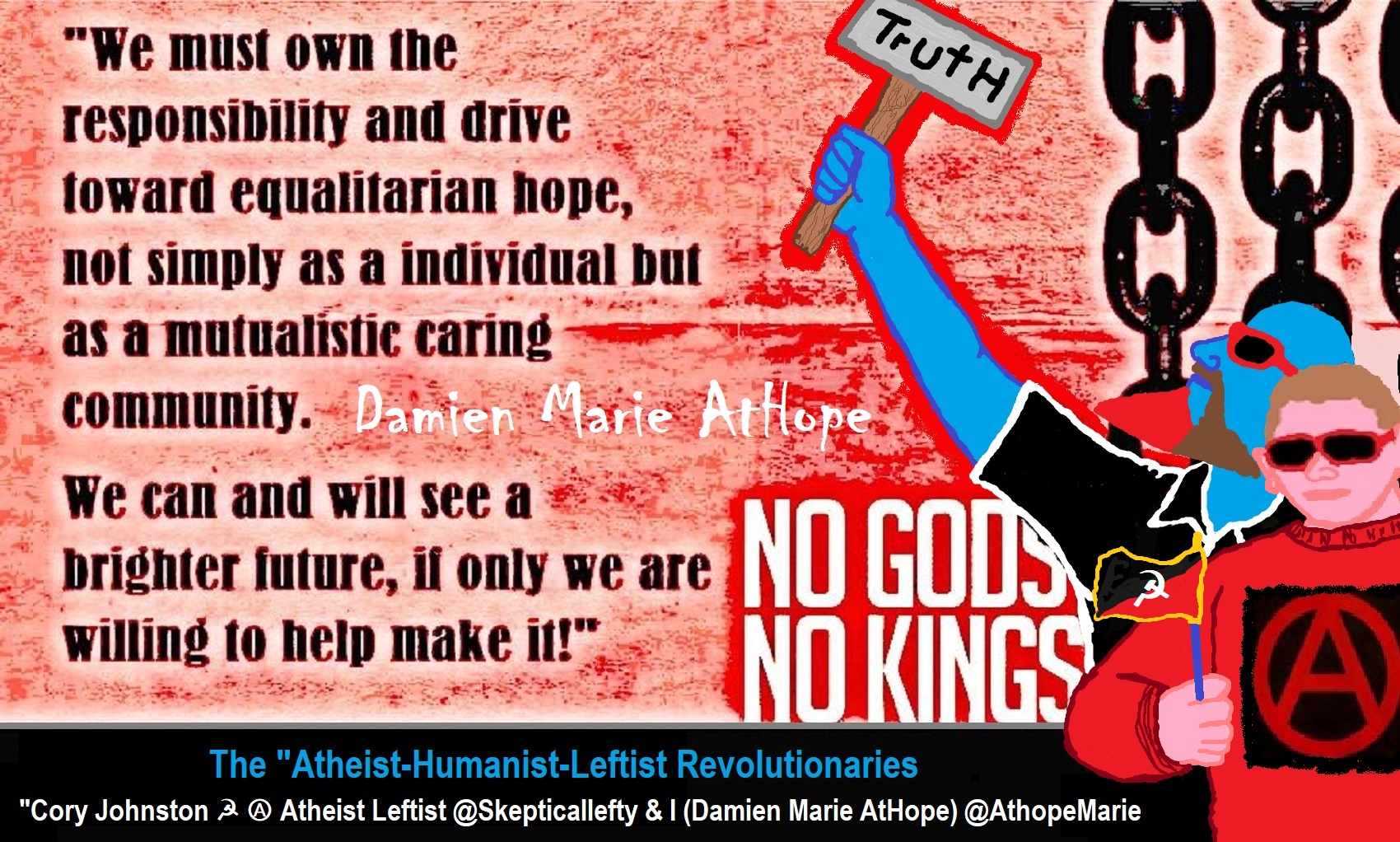
While hallucinogens are associated with shamanism, it is alcohol that is associated with paganism.
The Atheist-Humanist-Leftist Revolutionaries Shows in the prehistory series:
Show two: Pre-animism 300,000 years old and animism 100,000 years old: related to “Anarchism and Socialism”
Show tree: Totemism 50,000 years old: related to “Anarchism and Socialism”
Show four: Shamanism 30,000 years old: related to “Anarchism and Socialism”
Show five: Paganism 12,000 years old: related to “Anarchism and Socialism”
Show six: Emergence of hierarchy, sexism, slavery, and the new male god dominance: Paganism 7,000-5,000 years old: related to “Anarchism and Socialism” (Capitalism) (World War 0) Elite and their slaves!
Prehistory: related to “Anarchism and Socialism” the division of labor, power, rights, and recourses: VIDEO
Pre-animism 300,000 years old and animism 100,000 years old: related to “Anarchism and Socialism”: VIDEO
Totemism 50,000 years old: related to “Anarchism and Socialism”: VIDEO
Shamanism 30,000 years old: related to “Anarchism and Socialism”: VIDEO
Paganism 12,000 years old: related to “Anarchism and Socialism” (Pre-Capitalism): VIDEO
Paganism 7,000-5,000 years old: related to “Anarchism and Socialism” (Capitalism) (World War 0) Elite and their slaves: VIEDO
Paganism 5,000 years old: progressed organized religion and the state: related to “Anarchism and Socialism” (Kings and the Rise of the State): VIEDO
Paganism 4,000 years old: related to “Anarchism and Socialism” (First Moralistic gods, then the Origin time of Monotheism): VIEDO
I do not hate simply because I challenge and expose myths or lies any more than others being thought of as loving simply because of the protection and hiding from challenge their favored myths or lies.
The truth is best championed in the sunlight of challenge.
An archaeologist once said to me “Damien religion and culture are very different”
My response, So are you saying that was always that way, such as would you say Native Americans’ cultures are separate from their religions? And do you think it always was the way you believe?
I had said that religion was a cultural product. That is still how I see it and there are other archaeologists that think close to me as well. Gods too are the myths of cultures that did not understand science or the world around them, seeing magic/supernatural everywhere.
I personally think there is a goddess and not enough evidence to support a male god at Çatalhöyük but if there was both a male and female god and goddess then I know the kind of gods they were like Proto-Indo-European mythology.
This series idea was addressed in, Anarchist Teaching as Free Public Education or Free Education in the Public: VIDEO
Our 12 video series: Organized Oppression: Mesopotamian State Force and the Politics of power (9,000-4,000 years ago), is adapted from: The Complete and Concise History of the Sumerians and Early Bronze Age Mesopotamia (7000-2000 BC): https://www.youtube.com/watch?v=szFjxmY7jQA by “History with Cy“
Show #1: Mesopotamian State Force and the Politics of Power (Samarra, Halaf, Ubaid)
Show #2: Mesopotamian State Force and the Politics of Power (Eridu “Tell Abu Shahrain”)
Show #3: Mesopotamian State Force and the Politics of Power (Uruk and the First Cities)
Show #4: Mesopotamian State Force and the Politics of Power (First Kings)
Show #5: Mesopotamian State Force and the Politics of Power (Early Dynastic Period)
Show #6: Mesopotamian State Force and the Politics of Power (King/Ruler Lugalzagesi)
Show #7: Mesopotamian State Force and the Politics of Power (Sargon and Akkadian Rule)
Show #9: Mesopotamian State Force and the Politics of Power (Gudea of Lagash and Utu-hegal)
Show #12: Mesopotamian State Force and the Politics of Power (Aftermath and Legacy of Sumer)
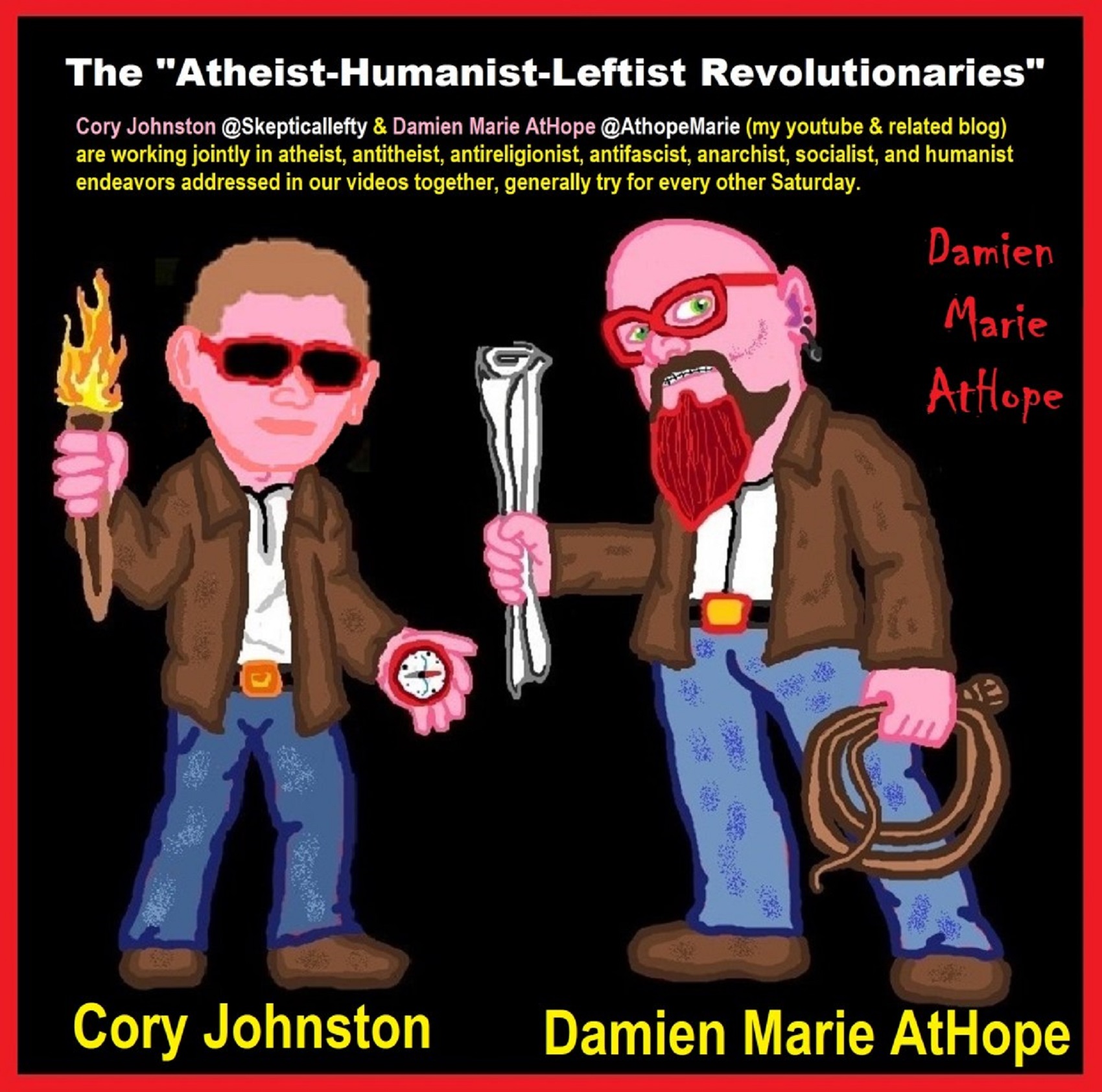
The “Atheist-Humanist-Leftist Revolutionaries”
Cory Johnston ☭ Ⓐ Atheist Leftist @Skepticallefty & I (Damien Marie AtHope) @AthopeMarie (my YouTube & related blog) are working jointly in atheist, antitheist, antireligionist, antifascist, anarchist, socialist, and humanist endeavors in our videos together, generally, every other Saturday.
Why Does Power Bring Responsibility?
Think, how often is it the powerless that start wars, oppress others, or commit genocide? So, I guess the question is to us all, to ask, how can power not carry responsibility in a humanity concept? I know I see the deep ethical responsibility that if there is power their must be a humanistic responsibility of ethical and empathic stewardship of that power. Will I be brave enough to be kind? Will I possess enough courage to be compassionate? Will my valor reach its height of empathy? I as everyone, earns our justified respect by our actions, that are good, ethical, just, protecting, and kind. Do I have enough self-respect to put my love for humanity’s flushing, over being brought down by some of its bad actors? May we all be the ones doing good actions in the world, to help human flourishing.
I create the world I want to live in, striving for flourishing. Which is not a place but a positive potential involvement and promotion; a life of humanist goal precision. To master oneself, also means mastering positive prosocial behaviors needed for human flourishing. I may have lost a god myth as an atheist, but I am happy to tell you, my friend, it is exactly because of that, leaving the mental terrorizer, god belief, that I truly regained my connected ethical as well as kind humanity.
Cory and I will talk about prehistory and theism, addressing the relevance to atheism, anarchism, and socialism.
At the same time as the rise of the male god, 7,000 years ago, there was also the very time there was the rise of violence, war, and clans to kingdoms, then empires, then states. It is all connected back to 7,000 years ago, and it moved across the world.
Cory Johnston: https://damienmarieathope.com/2021/04/cory-johnston-mind-of-a-skeptical-leftist/?v=32aec8db952d
The Mind of a Skeptical Leftist (YouTube)
Cory Johnston: Mind of a Skeptical Leftist @Skepticallefty
The Mind of a Skeptical Leftist By Cory Johnston: “Promoting critical thinking, social justice, and left-wing politics by covering current events and talking to a variety of people. Cory Johnston has been thoughtfully talking to people and attempting to promote critical thinking, social justice, and left-wing politics.” http://anchor.fm/skepticalleft
Cory needs our support. We rise by helping each other.
Cory Johnston ☭ Ⓐ @Skepticallefty Evidence-based atheist leftist (he/him) Producer, host, and co-host of 4 podcasts @skeptarchy @skpoliticspod and @AthopeMarie
Damien Marie AtHope (“At Hope”) Axiological Atheist, Anti-theist, Anti-religionist, Secular Humanist. Rationalist, Writer, Artist, Poet, Philosopher, Advocate, Activist, Psychology, and Armchair Archaeology/Anthropology/Historian.
Damien is interested in: Freedom, Liberty, Justice, Equality, Ethics, Humanism, Science, Atheism, Antiteism, Antireligionism, Ignosticism, Left-Libertarianism, Anarchism, Socialism, Mutualism, Axiology, Metaphysics, LGBTQI, Philosophy, Advocacy, Activism, Mental Health, Psychology, Archaeology, Social Work, Sexual Rights, Marriage Rights, Woman’s Rights, Gender Rights, Child Rights, Secular Rights, Race Equality, Ageism/Disability Equality, Etc. And a far-leftist, “Anarcho-Humanist.”
I am not a good fit in the atheist movement that is mostly pro-capitalist, I am anti-capitalist. Mostly pro-skeptic, I am a rationalist not valuing skepticism. Mostly pro-agnostic, I am anti-agnostic. Mostly limited to anti-Abrahamic religions, I am an anti-religionist.
To me, the “male god” seems to have either emerged or become prominent around 7,000 years ago, whereas the now favored monotheism “male god” is more like 4,000 years ago or so. To me, the “female goddess” seems to have either emerged or become prominent around 11,000-10,000 years ago or so, losing the majority of its once prominence around 2,000 years ago due largely to the now favored monotheism “male god” that grow in prominence after 4,000 years ago or so.
My Thought on the Evolution of Gods?
Animal protector deities from old totems/spirit animal beliefs come first to me, 13,000/12,000 years ago, then women as deities 11,000/10,000 years ago, then male gods around 7,000/8,000 years ago. Moralistic gods around 5,000/4,000 years ago, and monotheistic gods around 4,000/3,000 years ago.

Damien Marie AtHope (Said as “At” “Hope”)/(Autodidact Polymath but not good at math):
Axiological Atheist, Anti-theist, Anti-religionist, Secular Humanist, Rationalist, Writer, Artist, Jeweler, Poet, “autodidact” Philosopher, schooled in Psychology, and “autodidact” Armchair Archaeology/Anthropology/Pre-Historian (Knowledgeable in the range of: 1 million to 5,000/4,000 years ago). I am an anarchist socialist politically. Reasons for or Types of Atheism
My Website, My Blog, & Short-writing or Quotes, My YouTube, Twitter: @AthopeMarie, and My Email: damien.marie.athope@gmail.com


